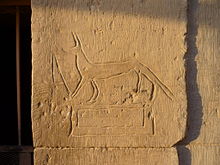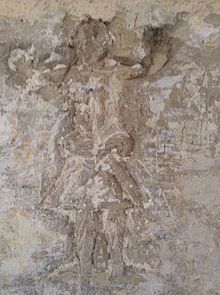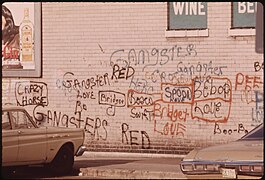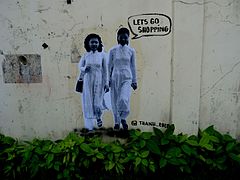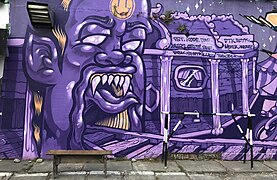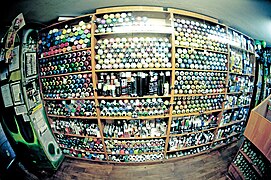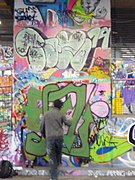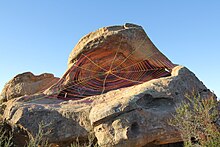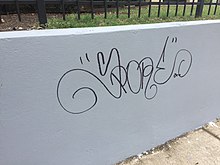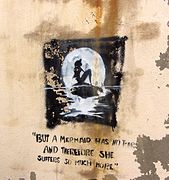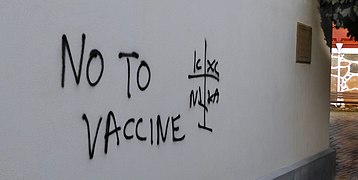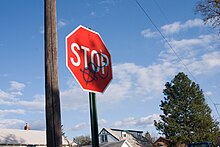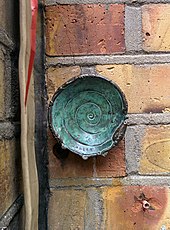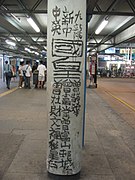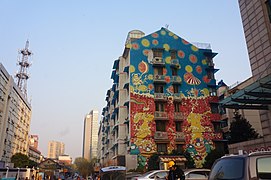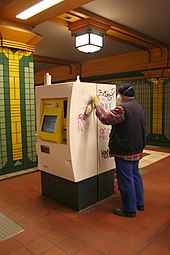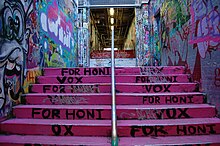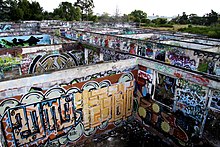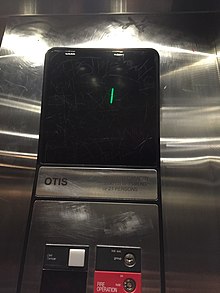Graffiti are writing or drawings that have been scribbled, scratched or painted illicitly on a wall or other surface, often within public view. The word graffiti, or its singular form “graffito”, come from the Italian word graffiato which means “scratched”. While the practice of creating graffiti has existed since ancient times, it come to the forefront as a modern art movement in the second half of the 20th century. Darryl McCray, known by his tagging name Cornbread, began the to write on the walls in Philadelphia in the late 1960s. The movement spread to New York City and blossomed into the modern graffiti movement, which reached its peak in the U.S. in the late 1970s and early 1980s, and then spread to Europe. Cornbread is widely regarded as the father of modern day graffiti. Today graffiti art is hugely popular and some of the best known artists in the world are street artists. Still graffiti is considered vandalism by authorities and many graffiti artists choose anonymity as a way to prevent arrest. Here are the 10 most famous graffiti artists in the world along with pictures of their best known works.
#10 Lee Quiñones

| Born: | 1964 |
| Nationality: | Puerto Rican |
The New York City Subway graffiti movement which took place in the 1970s and 1980s went on to have a massive local, countrywide and international impact on graffiti being recognized as an art form. George Lee Quinones was one of the innovators of New York’s street-art movement and is considered by many to be the single most influential graffiti artist to emerge from that era. He began painting graffiti on subway trains in 1974 and within a few years attained legendary status in this new field. Quinones often left poetic messages on his art pieces like “Graffiti is art and if art is a crime, please God, forgive me”. He created some of the most admired graffiti pieces at the time but unfortunately much of his finest work is lost forever. Quinones was one of the first artists to move from graffiti to canvas based paintings. Today he is a well established artist with his paintings housed at permanent collections of museums.
#9 Blu
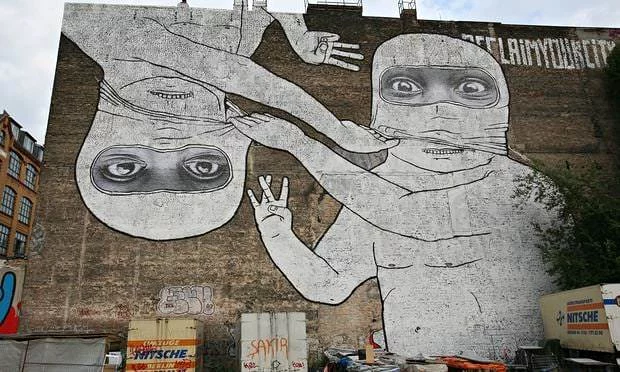
| Nationality: | Italian |
Blu is the pseudonym of an Italian graffiti artist who conceals his real identity. He became famous in 1999 by painting a series of illicit graffiti in the historical center and suburbs of Bologna in Italy. After initially using spray paint, the traditional medium of graffiti, Blu developed his characteristic style of using house paint which allowed him to paint larger murals and give a stronger intensity to his works. Blu stands against modern tendency to keep art elitist, unreachable and expensive. He is known for works which convey an important political or social message like his murals against globalization and capitalism; and for protection of human rights. Blu is one of the most active graffiti artists and his massive murals can be seen all over the world.
#8 Seen UA
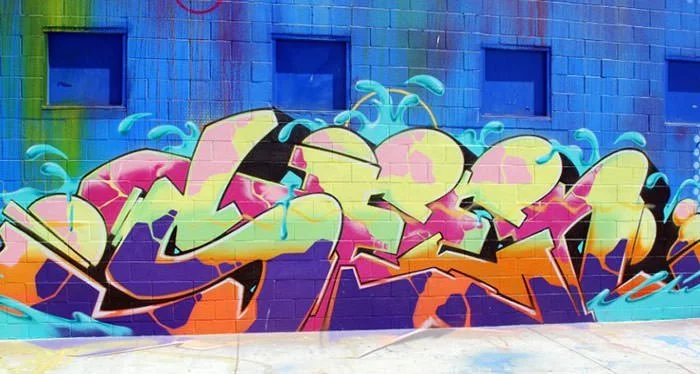
| Born: | 1961 |
| Nationality: | American |
Richard “Richie” Mirando, known as Seen UA, first started to paint on New York City Subway system in 1973, at the age of 12. Along with his crew, United Artists (UA), Seen quickly gained the reputation for producing full-color throw-ups on whole cars. He was one of the most renowned graffiti artists when graffiti as an art was still in its infancy. Seen is best known for his illustrations featuring comic heroes and television cartoons. His work has been published in many acclaimed books including Subway Art by Martha Cooper and Henry Chalfant; and American Graffiti by Margo Thompson. Seen is one of the most famous graffiti artists in the world and for his contribution to the movement, he is often referred to as the Godfather of Graffiti.
#7 Lady Pink
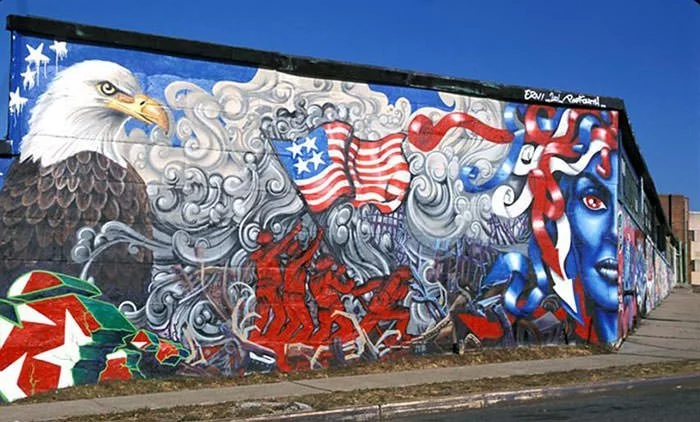
| Born: | 1964 |
| Nationality: | Ecuadorian |
Lady Pink is the tag name of Sandra Fabara who was born in Ambato, Ecuador; migrated to U.S. when she was seven; and was raised in New York City. She began her graffiti career at the age of 15 by painting subway trains. Fabara has focused her career on empowering women. She uses graffiti and murals to fight for equality, justice and women’s rights. She is also a well known canvas based artist and her paintings are included in important collections. Lady Pink was one of the first women to get involved in the graffiti culture and hence she is known as the “first lady of graffiti”. She is now a graffiti legend and has inspired many women to join the field. Fabara is also dedicated to the community and mentoring teens. She visits many schools to teach painting to young artists.
#6 Vhils
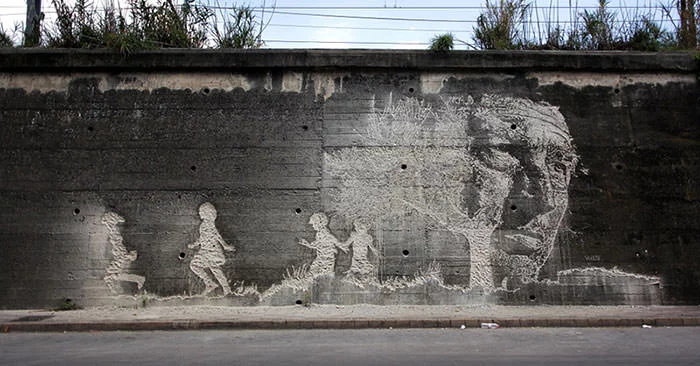
| Born: | 1987 |
| Nationality: | Portuguese |
Vhils is the pseudonym of Portuguese graffiti artist Alexandre Manuel Dias Farto. Farto moved on to graffiti at a mere age of 10. At the age of 13 he began to graffiti the suburban train lines of Lisbon. He then expanded to train lines outside of Lisbon, beyond Portugal, and finally across all of Europe. Vhils not only uses paint and other common street art materials to create graffiti but also uses chisels, hammers, drills, etching acid, bleach and other tools to carve his images out of the walls. He is most known for relief portraits which are carved on walls and created by a method involving drilling and controlled explosions among other things. He usually depicts ordinary, common citizens. Vhils is young as compared to other big names in street art but he is already regarded as one of the most skilled and innovative graffiti artists in the world. His works are described as poetic, complex and ambitious.
#5 Os Gemeos
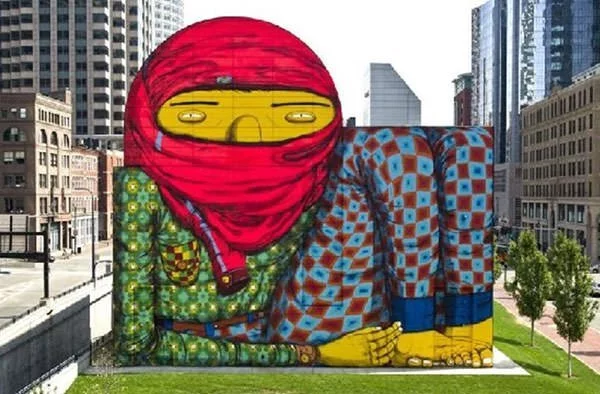
| Born: | 1974 |
| Nationality: | Brazilian |
This is a collaborative art duo of twins Otavio Pandolfo and Gustavo Pandolfo. Os Gemeos is a Portuguese word meaning “the twins”. Located in São Paulo, Brazil, the duo started their career in 1987 with spray-painting graffiti. They gradually became a major influence on the local art scene and then went on to help define the graffiti style of Brazil. Today they are renowned internationally with their work appearing on streets and in galleries across the world. Os Gemeos was initially influenced by American hip hop culture but with time they put Brazilian cultural elements into their graffiti. Their work includes complicated murals, family portraits, commentary on Sao Paulo’s social and political circumstances, and even Brazilian folklores. It stands out for its dream like aesthetics.
#4 Blek le Rat
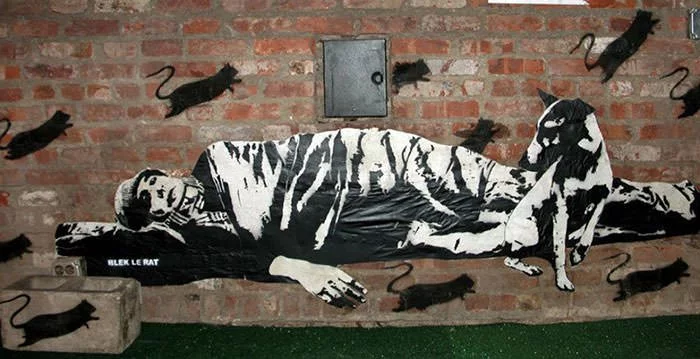
| Born: | 1952 |
| Nationality: | French |
Xavier Prou began his artistic career in 1981 by painting stencils of rats. His pseudonym Blek le Rat is taking from the cartoon “Blek le Roc” with rat being an anagram for “art”. He considered rat symbolic of freedom and the spread of the street art movement. Blek le Rat was the first to use pre-stenciled posters and images to create graffiti. This allowed him to apply the paint quickly as he didn’t want to stay too long on the street due to the fear of being caught. This later became a very popular technique among street artists and hence Blek le Rat is known as the “father of stencil graffiti”. With a career spanning more than three and a half decades, Blek le Rat is one of the most influential and revered graffiti artists in the world. He has inspired a generation of artists including Banksy who said that, “every time I think I’ve painted something slightly original, I find out that Blek le Rat has done it as well, only twenty years earlier.”
#3 Eduardo Kobra

| Born: | 1976 |
| Nationality: | Brazilian |
Born in a low income neighborhood in São Paulo, Eduardo Kobra discovered his passion for street art in his teens and he rose to prominence in the 1990s. He is best known for his massive-scale, brightly colored murals infused with bold lines. Kobra employs geometric shapes in multicolored backgrounds, embroiled shading and swirling effects to achieve a photo-realistic effect in his works. He also produces three-dimensional works. His most famous works include portraits of iconic figures in history. He also uses his street art to make statements against pollution, global warming, destruction of forests and war. Before the 2016 Rio Olympics, Kobra created an almost 3,000 square meters mural at the Olympic Boulevard which received the certificate from the Guinness World Records Book for the world’s largest graffiti art. Eduardo Kobra is the leading Brazilian graffiti artist and, along with Banksy and David Choe, one of the most famous graffiti artists in the world.
#2 David Choe
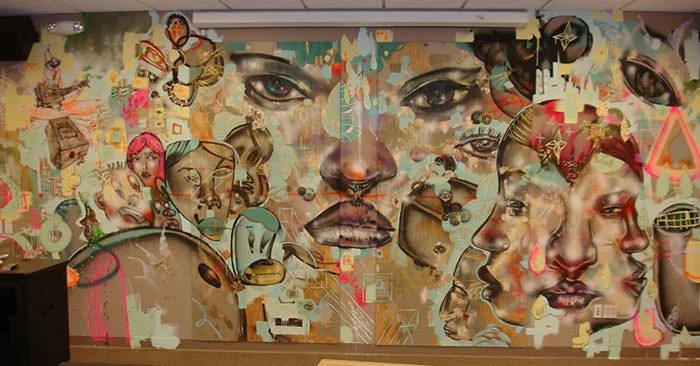
| Born: | 1976 |
| Nationality: | American |
Born to Korean immigrants in U.S., David Choe began his graffiti career in Los Angeles. A creative rebel, Choe is known for his bold and raw images; and he calls his style dirty. He often portrays explicit scenes of sexual nature; and explores the themes of desire, degradation and exaltation in many of his works. In 2005, Choe was asked to paint murals in the interior of Facebook’s first Silicon Valley office by Sean Parker, his fan and the first president of the social networking website. He painted graphic, explicit and sexual murals, and just two years later Facebook CEO Mark Zuckerberg asked him to paint somewhat tamer murals for their next office. Choe, a habitual gambler, chose to receive company stock instead of cash payment for the original Facebook murals. The value of his shares rose to around $200 million by 2012.
#1 Banksy
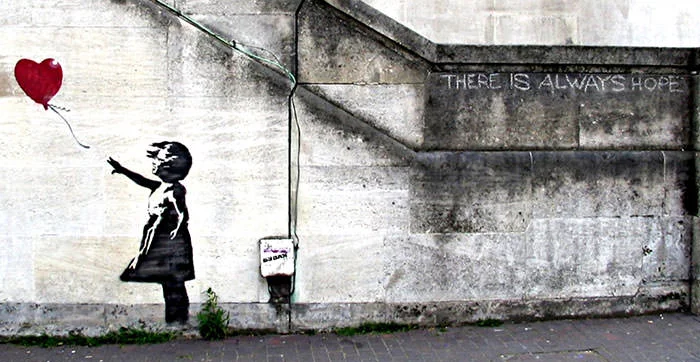
| Born: | 1974 |
| Nationality: | English |
Banksy is an anonymous graffiti artist and there remains much speculation about his identity and biographical details due to his massive popularity. He began his career in the 1990s in the Bristol underground scene, which also saw the rise of other well known figures including Robert Del Naja, founding member of the band Massive Attack. Banksy’s works of political and social commentary have been featured on streets, walls, and bridges of cities throughout the world. He has created some of the best known graffiti ever including Flower Thrower, The Mild Mild West and Balloon Girl. Balloon Girl was ranked as the favorite artwork in United Kingdom in a 2017 Samsung poll. The popularity of Banksy has led to recognition of many other important artists in the field of graffiti art. He was awarded the Person of the Year at the 2014 Webby Awards. Banksy is the most famous graffiti artist and he has without a doubt made the biggest contribution in making street art popular.
The purpose of graffiti
Graffiti as a form of artistic expression, often associated with subcultures as the rebel against authority. Graffiti in its origins was used to publicly display the artistic expressions in response to the lack of access to museums and art institutions, and the continuous strife, discrimination, and struggle of living in the city.
Because graffiti is illegal in most cases, this form of art has flourished in the underground, requiring little money and providing an opportunity to voice what is often excluded from dominant histories and media. From here, although graffiti remains the major form of street art with other mediums have evolved — including stenciling, stickers, and wheatpasting.
On the other hand, artists also used graffiti as a tool, to express their political opinions, (indigenous) heritage, cultural and religious imagery, and counter-narratives to dominant portrayals of life in the barrios. Similar to other forms of art within, graffiti has become another tool of resistance, reclamation, and empowerment to make the artist own space for expression and popular education.
Nowadays, graffiti is commonly recognized as a form of public art, embraced by museums, art critics, and art institutions. But its significance for many people remains in the barrios (neighborhoods), reiterating the importance of accessibility and inclusion in relation to their identity and community in their artwork.
Graffiti (plural; singular graffiti or graffito, the latter rarely used except in archeology) is art that is written, painted or drawn on a wall or other surface, usually without permission and within public view.[1][2] Graffiti ranges from simple written words to elaborate wall paintings, and has existed since ancient times, with examples dating back to ancient Egypt, ancient Greece, and the Roman Empire (see also mural).[3]
Graffiti is a controversial subject. In most countries, marking or painting property without permission is considered by property owners and civic authorities as defacement and vandalism, which is a punishable crime, citing the use of graffiti by street gangs to mark territory or to serve as an indicator of gang-related activities.[4] Graffiti has become visualized as a growing urban «problem» for many cities in industrialized nations, spreading from the New York City subway system and Philadelphia in the early 1970s to the rest of the United States and Europe and other world regions.[5]
Etymology
«Graffiti» (usually both singular and plural) and the rare singular form «graffito» are from the Italian word graffiato («scratched»).[6][1][2] The term «graffiti» is used in art history for works of art produced by scratching a design into a surface. A related term is «sgraffito»,[7] which involves scratching through one layer of pigment to reveal another beneath it. This technique was primarily used by potters who would glaze their wares and then scratch a design into it. In ancient times graffiti were carved on walls with a sharp object, although sometimes chalk or coal were used. The word originates from Greek γράφειν—graphein—meaning «to write».[8]
History
Figure graffito, similar to a relief, at the Castellania, in Valletta
The term graffiti originally referred to the inscriptions, figure drawings, and such, found on the walls of ancient sepulchres or ruins, as in the Catacombs of Rome or at Pompeii. Use of the word has evolved to include any graphics applied to surfaces in a manner that constitutes vandalism.[9]
The only known source of the Safaitic language, an ancient form of Arabic, is from graffiti: inscriptions scratched on to the surface of rocks and boulders in the predominantly basalt desert of southern Syria, eastern Jordan and northern Saudi Arabia. Safaitic dates from the first century BC to the fourth century AD.[10][11]
Modern-style graffiti
The first known example of «modern style»[clarification needed] graffiti survives in the ancient Greek city of Ephesus (in modern-day Turkey). Local guides say it is an advertisement for prostitution. Located near a mosaic and stone walkway, the graffiti shows a handprint that vaguely resembles a heart, along with a footprint, a number, and a carved image of a woman’s head.
The ancient Romans carved graffiti on walls and monuments, examples of which also survive in Egypt. Graffiti in the classical world had different connotations than they carry in today’s society concerning content. Ancient graffiti displayed phrases of love declarations, political rhetoric, and simple words of thought, compared to today’s popular messages of social and political ideals.[12]
The eruption of Vesuvius preserved graffiti in Pompeii, which includes Latin curses, magic spells, declarations of love, insults, alphabets, political slogans, and famous literary quotes, providing insight into ancient Roman street life. One inscription gives the address of a woman named Novellia Primigenia of Nuceria, a prostitute, apparently of great beauty, whose services were much in demand. Another shows a phallus accompanied by the text, mansueta tene («handle with care»).
Disappointed love also found its way onto walls in antiquity:
Quisquis amat. veniat. Veneri volo frangere costas
fustibus et lumbos debilitare deae.
Si potest illa mihi tenerum pertundere pectus
quit ego non possim caput illae frangere fuste?Whoever loves, go to hell. I want to break Venus’s ribs
with a club and deform her hips.
If she can break my tender heart
why can’t I hit her over the head?— CIL IV, 1824.[13]
Ancient tourists visiting the 5th-century citadel at Sigiriya in Sri Lanka scribbled over 1800 individual graffiti there between the 6th and 18th centuries. Etched on the surface of the Mirror Wall, they contain pieces of prose, poetry, and commentary. The majority of these visitors appear to have been from the elite of society: royalty, officials, professions, and clergy. There were also soldiers, archers, and even some metalworkers. The topics range from love to satire, curses, wit, and lament. Many demonstrate a very high level of literacy and a deep appreciation of art and poetry.[14] Most of the graffiti refer to the frescoes of semi-nude females found there. One reads:
Wet with cool dew drops
fragrant with perfume from the flowers
came the gentle breeze
jasmine and water lily
dance in the spring sunshine
side-long glances
of the golden-hued ladies
stab into my thoughts
heaven itself cannot take my mind
as it has been captivated by one lass
among the five hundred I have seen here.[15]
Among the ancient political graffiti examples were Arab satirist poems. Yazid al-Himyari, an Umayyad Arab and Persian poet, was most known for writing his political poetry on the walls between Sajistan and Basra, manifesting a strong hatred towards the Umayyad regime and its walis, and people used to read and circulate them very widely.[16][clarification needed]
Level of literacy often evident in graffiti
Historic forms of graffiti have helped gain understanding into the lifestyles and languages of past cultures. Errors in spelling and grammar in these graffiti offer insight into the degree of literacy in Roman times and provide clues on the pronunciation of spoken Latin. Examples are CIL IV, 7838: Vettium Firmum / aed[ilem] quactiliar[ii] [sic] rog[ant]. Here, «qu» is pronounced «co». The 83 pieces of graffiti found at CIL IV, 4706-85 are evidence of the ability to read and write at levels of society where literacy might not be expected. The graffiti appear on a peristyle which was being remodeled at the time of the eruption of Vesuvius by the architect Crescens. The graffiti were left by both the foreman and his workers. The brothel at CIL VII, 12, 18–20 contains more than 120 pieces of graffiti, some of which were the work of the prostitutes and their clients. The gladiatorial academy at CIL IV, 4397 was scrawled with graffiti left by the gladiator Celadus Crescens (Suspirium puellarum Celadus thraex: «Celadus the Thracian makes the girls sigh.»)
Another piece from Pompeii, written on a tavern wall about the owner of the establishment and his questionable wine:
Landlord, may your lies malign
Bring destruction on your head!
You yourself drink unmixed wine,
Water [do you] sell [to] your guests instead.[17]
It was not only the Greeks and Romans who produced graffiti: the Maya site of Tikal in Guatemala contains examples of ancient Maya graffiti. Viking graffiti survive in Rome and at Newgrange Mound in Ireland, and a Varangian scratched his name (Halvdan) in runes on a banister in the Hagia Sophia at Constantinople. These early forms of graffiti have contributed to the understanding of lifestyles and languages of past cultures.
Graffiti, known as Tacherons, were frequently scratched on Romanesque Scandinavian church walls.[18]
When Renaissance artists such as Pinturicchio, Raphael, Michelangelo, Ghirlandaio, or Filippino Lippi descended into the ruins of Nero’s Domus Aurea, they carved or painted their names and returned to initiate the grottesche style of decoration.[19][20]
There are also examples of graffiti occurring in American history, such as Independence Rock, a national landmark along the Oregon Trail.[21]
Later, French soldiers carved their names on monuments during the Napoleonic campaign of Egypt in the 1790s.[22] Lord Byron’s survives on one of the columns of the Temple of Poseidon at Cape Sounion in Attica, Greece.[23]
- Ancient graffiti
-
Ironic wall inscription commenting on boring graffiti
-
-
-
Crusader graffiti in the Church of the Holy Sepulchre
-
-
Contemporary graffiti
Contemporary graffiti art has its origins with young people in 1970s New York. They would use spray paint and other kind of materials to create an image on the sides of buildings and subway trains. [24] While the art was a form of masterpiece, it was also causing problems on subways due to the fact that people could not look out of the widows because they were covered in tags.[25] To the people doing the tags it was to them a form of writing it was not until a novelist named Norman Mailer called it «Graffiti» in The New York Times.[25] During this time period (the late 70s), a war against graffiti broke out, making it so graffitist cannot tag subway trains without getting in trouble anymore, so they moved on to tagging rooftops and canvases.[25] However, today graffitist are paid thousands of dollars to put there artwork on buildings and on canvases to display the amazing works that the artist has done.[26]
Contemporary graffiti style has been heavily influenced by hip hop culture[27] and the myriad international styles derived from Philadelphia and New York City Subway graffiti, however, there are many other traditions of notable graffiti in the twentieth century. Graffiti have long appeared on building walls, in latrines, railroad boxcars, subways, and bridges.
The oldest known example of modern graffiti are the «monikers» found on traincars created by hobos and railworkers since the late 1800s. The Bozo Texino monikers were documented by filmmaker Bill Daniel in his 2005 film, Who is Bozo Texino?.[28][29]
Some graffiti have their own poignancy. In World War II, an inscription on a wall at the fortress of Verdun was seen as an illustration of the US response twice in a generation to the wrongs of the Old World:[30][31]
Austin White – Chicago, Ill – 1918
Austin White – Chicago, Ill – 1945
This is the last time I want to write my name here.
During World War II and for decades after, the phrase «Kilroy was here» with an accompanying illustration was widespread throughout the world, due to its use by American troops and ultimately filtering into American popular culture. Shortly after the death of Charlie Parker (nicknamed «Yardbird» or «Bird»), graffiti began appearing around New York with the words «Bird Lives».[32] The student protests and general strike of May 1968 saw Paris bedecked in revolutionary, anarchistic, and situationist slogans such as L’ennui est contre-révolutionnaire («Boredom is counterrevolutionary») expressed in painted graffiti, poster art, and stencil art. At the time in the US, other political phrases (such as «Free Huey» about Black Panther Huey Newton) became briefly popular as graffiti in limited areas, only to be forgotten. A popular graffito of the early 1970s was «Dick Nixon Before He Dicks You», reflecting the hostility of the youth culture to that US president.
- World War II graffiti
-
Soldier with tropical fantasy graffiti (1943–1944)
-
Advent of aerosol paint
Rock and roll graffiti is a significant subgenre. A famous graffito of the twentieth century was the inscription in London reading «Clapton is God» in reference to the guitarist Eric Clapton. Creating the cult of the guitar hero, the phrase was spray-painted by an admirer on a wall in an Islington, north London in the autumn of 1967.[33] The graffito was captured in a photograph, in which a dog is urinating on the wall.[34]
Graffiti also became associated with the anti-establishment punk rock movement beginning in the 1970s. Bands such as Black Flag and Crass (and their followers) widely stenciled their names and logos, while many punk night clubs, squats, and hangouts are famous for their graffiti.
- Early spray-painted graffiti
-
Graffiti in Chicago (1973)
Spread of hip hop culture
Style Wars depicted not only famous graffitists such as Skeme, Dondi, MinOne, and ZEPHYR, but also reinforced graffiti’s role within New York’s emerging hip-hop culture by incorporating famous early break-dancing groups such as Rock Steady Crew into the film and featuring rap in the soundtrack. Although many officers of the New York City Police Department found this film to be controversial, Style Wars is still recognized as the most prolific film representation of what was going on within the young hip hop culture of the early 1980s.[35] Fab 5 Freddy and Futura 2000 took hip hop graffiti to Paris and London as part of the New York City Rap Tour in 1983.[36]
Stencil graffiti emerges
This period also saw the emergence of the new stencil graffiti genre. Some of the first examples were created in 1981 by graffitists Blek le Rat in Paris, in 1982 by Jef Aerosol in Tours (France);[citation needed] by 1985 stencils had appeared in other cities including New York City, Sydney, and Melbourne, where they were documented by American photographer Charles Gatewood and Australian photographer Rennie Ellis.[37]
Commercialization and entrance into mainstream pop culture
With the popularity and legitimization of graffiti has come a level of commercialization. In 2001, computer giant IBM launched an advertising campaign in Chicago and San Francisco which involved people spray painting on sidewalks a peace symbol, a heart, and a penguin (Linux mascot), to represent «Peace, Love, and Linux.» IBM paid Chicago and San Francisco collectively US$120,000 for punitive damages and clean-up costs.[38][39]
In 2005, a similar ad campaign was launched by Sony and executed by its advertising agency in New York, Chicago, Atlanta, Philadelphia, Los Angeles, and Miami, to market its handheld PSP gaming system. In this campaign, taking notice of the legal problems of the IBM campaign, Sony paid building owners for the rights to paint on their buildings «a collection of dizzy-eyed urban kids playing with the PSP as if it were a skateboard, a paddle, or a rocking horse».[39]
Advocates
Marc Ecko, an urban clothing designer, has been an advocate of graffiti as an art form during this period, stating that «Graffiti is without question the most powerful art movement in recent history and has been a driving inspiration throughout my career.»[40]
Graffiti have become a common stepping stone for many members of both the art and design communities in North America and abroad. Within the United States graffitists such as Mike Giant, Pursue, Rime, Noah, and countless others have made careers in skateboard, apparel, and shoe design for companies such as DC Shoes, Adidas, Rebel8, Osiris, or Circa[41] Meanwhile, there are many others such as DZINE, Daze, Blade, and The Mac who have made the switch to being gallery artists, often not even using their initial medium, spray paint.[41]
Global developments
South America
Tristan Manco wrote that Brazil «boasts a unique and particularly rich, graffiti scene … [earning] it an international reputation as the place to go for artistic inspiration.» Graffiti «flourishes in every conceivable space in Brazil’s cities.» Artistic parallels «are often drawn between the energy of São Paulo today and 1970s New York.» The «sprawling metropolis,» of São Paulo has «become the new shrine to graffiti;» Manco alludes to «poverty and unemployment … [and] the epic struggles and conditions of the country’s marginalised peoples,» and to «Brazil’s chronic poverty,» as the main engines that «have fuelled a vibrant graffiti culture.» In world terms, Brazil has «one of the most uneven distributions of income. Laws and taxes change frequently.» Such factors, Manco argues, contribute to a very fluid society, riven with those economic divisions and social tensions that underpin and feed the «folkloric vandalism and an urban sport for the disenfranchised,» that is South American graffiti art.[42]
A graffiti piece found in Tel Aviv by the artist DeDe
Prominent Brazilian graffitists include Os Gêmeos, Boleta, Nunca, Nina, Speto, Tikka, and T.Freak.[43] Their artistic success and involvement in commercial design ventures[44] has highlighted divisions within the Brazilian graffiti community between adherents of the cruder transgressive form of pichação and the more conventionally artistic values of the practitioners of grafite.[45]
Middle East
Graffiti in the Middle East has emerged slowly, with taggers operating in Egypt, Lebanon, the Gulf countries like Bahrein or the United Arab Emirates,[46] Israel, and in Iran. The major Iranian newspaper Hamshahri has published two articles on illegal writers in the city with photographic coverage of Iranian artist A1one’s works on Tehran walls. Tokyo-based design magazine, PingMag, has interviewed A1one and featured photographs of his work.[47] The Israeli West Bank barrier has become a site for graffiti, reminiscent in this sense of the Berlin Wall. Many graffitists in Israel come from other places around the globe, such as JUIF from Los Angeles and DEVIONE from London. The religious reference «נ נח נחמ נחמן מאומן» («Na Nach Nachma Nachman Meuman») is commonly seen in graffiti around Israel.
Graffiti has played an important role within the street art scene in the Middle East and North Africa (MENA), especially following the events of the Arab Spring of 2011 or the Sudanese Revolution of 2018/19.[48] Graffiti is a tool of expression in the context of conflict in the region, allowing people to raise their voices politically and socially. Famous street artist Banksy has had an important effect in the street art scene in the MENA area, especially in Palestine where some of his works are located in the West Bank barrier and Bethlehem.[49]
Southeast Asia
There are also a large number of graffiti influences in Southeast Asian countries that mostly come from modern Western culture, such as Malaysia, where graffiti have long been a common sight in Malaysia’s capital city, Kuala Lumpur. Since 2010, the country has begun hosting a street festival to encourage all generations and people from all walks of life to enjoy and encourage Malaysian street culture.[50]
- Graffiti around the world
-
-
-
Characteristics of common graffiti
Methods and production
The modern-day graffitists can be found with an arsenal of various materials that allow for a successful production of a piece.[51] This includes such techniques as scribing. However, spray paint in aerosol cans is the number one medium for graffiti. From this commodity comes different styles, technique, and abilities to form master works of graffiti. Spray paint can be found at hardware and art stores and comes in virtually every color.
Stencil graffiti is created by cutting out shapes and designs in a stiff material (such as cardboard or subject folders) to form an overall design or image. The stencil is then placed on the «canvas» gently and with quick, easy strokes of the aerosol can, the image begins to appear on the intended surface.
- Graffiti making
-
The first graffiti shop in Russia was opened in 1992 in Tver
-
Graffiti application at Eurofestival in Turku, Finland
-
Graffiti application in India using natural pigments (mostly charcoal, plant saps, and dirt)
-
A graffiti artist at work in London
Modern experimentation
Spiderweb Yarnbomb Installation by Stephen Duneier both hides and highlights previous graffiti.
Modern graffiti art often incorporates additional arts and technologies. For example, Graffiti Research Lab has encouraged the use of projected images and magnetic light-emitting diodes (throwies) as new media for graffitists. Yarnbombing is another recent form of graffiti. Yarnbombers occasionally target previous graffiti for modification, which had been avoided among the majority of graffitists.
Tagging
Tagging is the practice of someone spray-painting «their name, initial or logo onto a public surface».[52]
A tag in Dallas, reading «Spore»
A number of recent examples of graffiti make use of hashtags.[53][54]
Densely-tagged parking area in Århus, Denmark
Uses
Theories on the use of graffiti by avant-garde artists have a history dating back at least to the Asger Jorn, who in 1962 painting declared in a graffiti-like gesture «the avant-garde won’t give up».[55]
Many contemporary analysts and even art critics have begun to see artistic value in some graffiti and to recognize it as a form of public art. According to many art researchers, particularly in the Netherlands and in Los Angeles, that type of public art is, in fact an effective tool of social emancipation or, in the achievement of a political goal.[56]
In times of conflict, such murals have offered a means of communication and self-expression for members of these socially, ethnically, or racially divided communities, and have proven themselves as effective tools in establishing dialog and thus, of addressing cleavages in the long run. The Berlin Wall was also extensively covered by graffiti reflecting social pressures relating to the oppressive Soviet rule over the GDR.
Many artists involved with graffiti are also concerned with the similar activity of stenciling. Essentially, this entails stenciling a print of one or more colors using spray-paint. Recognized while exhibiting and publishing several of her coloured stencils and paintings portraying the Sri Lankan Civil War and urban Britain in the early 2000s, graffitists Mathangi Arulpragasam, aka M.I.A., has also become known for integrating her imagery of political violence into her music videos for singles «Galang» and «Bucky Done Gun», and her cover art. Stickers of her artwork also often appear around places such as London in Brick Lane, stuck to lamp posts and street signs, she having become a muse for other graffitists and painters worldwide in cities including Seville.
Graffitist believes that art should be on display for everyone in the public eye or in plain sight, not hidden away in a museum or a gallery. [57]Art should color the streets, not the inside of some building. Graffiti is a form of art that can’t be owned or bought. It doesn’t last forever, it’s temporary, yet one of a kind. It’s a form of self promotion for the artist that can be displayed anywhere form sidewalks, roofs, subways, building wall, and etc. [57] Art to them is for everyone and should be showed to everyone for free.
Personal expression
Graffiti is a way of communicating and a way of expressing what one feels in the moment. It is both art and a functional thing that can warn people of something or inform people of something. However, graffiti is to some people a form of art, but to some a form of vandalism.[58] And many graffitists choose to protect their identities and remain anonymous or to hinder prosecution.
With the commercialization of graffiti (and hip hop in general), in most cases, even with legally painted «graffiti» art, graffitists tend to choose anonymity. This may be attributed to various reasons or a combination of reasons. Graffiti still remains the one of four hip hop elements that is not considered «performance art» despite the image of the «singing and dancing star» that sells hip hop culture to the mainstream. Being a graphic form of art, it might also be said that many graffitists still fall in the category of the introverted archetypal artist.
Banksy is one of the world’s most notorious and popular street artists who continues to remain faceless in today’s society.[59] He is known for his political, anti-war stencil art mainly in Bristol, England, but his work may be seen anywhere from Los Angeles to Palestine. In the UK, Banksy is the most recognizable icon for this cultural artistic movement and keeps his identity a secret to avoid arrest. Much of Banksy’s artwork may be seen around the streets of London and surrounding suburbs, although he has painted pictures throughout the world, including the Middle East, where he has painted on Israel’s controversial West Bank barrier with satirical images of life on the other side. One depicted a hole in the wall with an idyllic beach, while another shows a mountain landscape on the other side. A number of exhibitions also have taken place since 2000, and recent works of art have fetched vast sums of money. Banksy’s art is a prime example of the classic controversy: vandalism vs. art. Art supporters endorse his work distributed in urban areas as pieces of art and some councils, such as Bristol and Islington, have officially protected them, while officials of other areas have deemed his work to be vandalism and have removed it.
Pixnit is another artist who chooses to keep her identity from the general public.[60] Her work focuses on beauty and design aspects of graffiti as opposed to Banksy’s anti-government shock value. Her paintings are often of flower designs above shops and stores in her local urban area of Cambridge, Massachusetts. Some store owners endorse her work and encourage others to do similar work as well. «One of the pieces was left up above Steve’s Kitchen, because it looks pretty awesome»- Erin Scott, the manager of New England Comics in Allston, Massachusetts.[61]
Graffiti artists may become offended if photographs of their art are published in a commercial context without their permission. In March 2020, the Finnish graffiti artist Psyke expressed his displeasure at the newspaper Ilta-Sanomat publishing a photograph of a Peugeot 208 in an article about new cars, with his graffiti prominently shown on the background. The artist claims he does not want his art being used in commercial context, not even if he were to receive compensation.[62]
- Personal graffiti
-
Inscription in Pompeii lamenting a frustrated love, «Whoever loves, let him flourish, let him perish who knows not love, let him perish twice over whoever forbids love.»
-
-
Territorial
Territorial graffiti marks urban neighborhoods with tags and logos to differentiate certain groups from others. These images are meant to show outsiders a stern look at whose turf is whose. The subject matter of gang-related graffiti consists of cryptic symbols and initials strictly fashioned with unique calligraphies. Gang members use graffiti to designate membership throughout the gang, to differentiate rivals and associates and, most commonly, to mark borders which are both territorial and ideological.[63]
As advertising
Graffiti has been used as a means of advertising both legally and illegally. Bronx-based TATS CRU has made a name for themselves doing legal advertising campaigns for companies such as Coca-Cola, McDonald’s, Toyota, and MTV. In the UK, Covent Garden’s Boxfresh used stencil images of a Zapatista revolutionary in the hopes that cross referencing would promote their store.
Smirnoff hired artists to use reverse graffiti (the use of high pressure hoses to clean dirty surfaces to leave a clean image in the surrounding dirt) to increase awareness of their product.
- Advertising graffiti
-
Graffiti as advertising in Haikou, Hainan Province, China, which is an extremely common form of graffiti seen throughout the country
-
Graffiti as legal advertising on a grocer’s shop window in Warsaw, Poland
Radical and political
Graffiti often has a reputation as part of a subculture that rebels against authority, although the considerations of the practitioners often diverge and can relate to a wide range of attitudes. It can express a political practice and can form just one tool in an array of resistance techniques. One early example includes the anarcho-punk band Crass, who conducted a campaign of stenciling anti-war, anarchist, feminist, and anti-consumerist messages throughout the London Underground system during the late 1970s and early 1980s.[64] In Amsterdam graffiti was a major part of the punk scene. The city was covered with names such as «De Zoot», «Vendex», and «Dr Rat».[65] To document the graffiti a punk magazine was started that was called Gallery Anus. So when hip hop came to Europe in the early 1980s there was already a vibrant graffiti culture.
The student protests and general strike of May 1968 saw Paris bedecked in revolutionary, anarchistic, and situationist slogans such as L’ennui est contre-révolutionnaire («Boredom is counterrevolutionary») and Lisez moins, vivez plus («Read less, live more»). While not exhaustive, the graffiti gave a sense of the ‘millenarian’ and rebellious spirit, tempered with a good deal of verbal wit, of the strikers.
I think graffiti writing is a way of defining what our generation is like. Excuse the French, we’re not a bunch of p—- artists. Traditionally artists have been considered soft and mellow people, a little bit kooky. Maybe we’re a little bit more like pirates that way. We defend our territory, whatever space we steal to paint on, we defend it fiercely.
—Sandra «Lady Pink» Fabara[66]
The developments of graffiti art which took place in art galleries and colleges as well as «on the street» or «underground», contributed to the resurfacing in the 1990s of a far more overtly politicized art form in the subvertising, culture jamming, or tactical media movements. These movements or styles tend to classify the artists by their relationship to their social and economic contexts, since, in most countries, graffiti art remains illegal in many forms except when using non-permanent paint. Since the 1990s with the rise of Street Art, a growing number of artists are switching to non-permanent paints and non-traditional forms of painting.[67][68]
Contemporary practitioners, accordingly, have varied and often conflicting practices. Some individuals, such as Alexander Brener, have used the medium to politicize other art forms, and have used the prison sentences enforced on them as a means of further protest.[69]
The practices of anonymous groups and individuals also vary widely, and practitioners by no means always agree with each other’s practices. For example, the anti-capitalist art group the Space Hijackers did a piece in 2004 about the contradiction between the capitalistic elements of Banksy and his use of political imagery.[70][71]
Berlin human rights activist Irmela Mensah-Schramm has received global media attention and numerous awards for her 35-year campaign of effacing neo-Nazi and other right-wing extremist graffiti throughout Germany, often by altering hate speech in humorous ways.[72][73]
- Political graffiti around the world
-
Graffiti with orthodox cross at the Catholic Church in Ystad 2021.
-
-
Anti Iraqi war graffiti by street artist Sony Montana in Cancun, Mexico (2007)
-
WWII bunker near Anhalter Bahnhof (Berlin) with a graffiti inscription Wer Bunker baut, wirft Bomben (those who build bunkers, throw bombs)
-
Graffiti on the train line leading to Central Station in Amsterdam
-
Stencil in Pieksämäki representing former president of Finland, Urho Kekkonen, well known in Finnish popular culture
-
Berlin Wall: «Anyone who wants to keep the world as it is, does not want it to remain»
Genocide denial
In Serbian capital, Belgrade, the graffiti depicting a uniformed former general of Serb army and war criminal, convicted at ICTY for war crimes and crimes against humanity, including genocide and ethnic cleansing in Bosnian War, Ratko Mladić, appeared in a military salute alongside the words, «General, thank to your mother».[74]
Aleks Eror, Berlin-based journalist, explains how «veneration of historical and wartime figures» through street art is not a new phenomenon in the region of former Yugoslavia, and that «in most cases is firmly focused on the future, rather than retelling the past».[75] Eror is not only analyst pointing to danger of such an expressions for the region’s future. In a long expose on the subject of Bosnian genocide denial, at Balkan Diskurs magazine and multimedia platform website, Kristina Gadže and Taylor Whitsell referred to these experiences as a young generations’ «cultural heritage», in which young are being exposed to celebration and affirmation of war-criminals as part of their «formal education» and «inheritance».[76]
There are numerous examples of genocide denial through celebration and affirmation of war criminals throughout the region of Western Balkans inhabited by Serbs using this form of artistic expression. Several more of these graffiti are found in Serbian capital, and many more across Serbia and Bosnian and Herzegovinian administrative entity, Republika Srpska, which is the ethnic Serbian majority enclave.[75][77] Critics point that Serbia as a state, is willing to defend the mural of convicted war criminal, and have no intention to react on cases of genocide denial, noting that Interior Minister of Serbia, Aleksandar Vulin decision to ban any gathering with an intent to remove the mural, with the deployment of riot police, sends the message of «tacit endorsement».[74][78] Consequently, on 9 November 2021, Serbian heavy police in riot gear, with graffiti creators and their supporters,[76] blocked the access to the mural to prevent human rights groups and other activists to paint over it and mark the International Day Against Fascism and Antisemitism in that way,[74] and even arrested two civic activist for throwing eggs at the graffiti.[78]
Offensive graffiti
Graffiti may also be used as an offensive expression. This form of graffiti may be difficult to identify, as it is mostly removed by the local authority (as councils which have adopted strategies of criminalization also strive to remove graffiti quickly).[79] Therefore, existing racist graffiti is mostly more subtle and at first sight, not easily recognized as «racist». It can then be understood only if one knows the relevant «local code» (social, historical, political, temporal, and spatial), which is seen as heteroglot and thus a ‘unique set of conditions’ in a cultural context.[80]
- A spatial code for example, could be that there is a certain youth group in an area that is engaging heavily in racist activities. So, for residents (knowing the local code), a graffiti containing only the name or abbreviation of this gang already is a racist expression, reminding the offended people of their gang activities. Also a graffiti is in most cases, the herald of more serious criminal activity to come.[81] A person who does not know these gang activities would not be able to recognize the meaning of this graffiti. Also if a tag of this youth group or gang is placed on a building occupied by asylum seekers, for example, its racist character is even stronger.
By making the graffiti less explicit (as adapted to social and legal constraints),[82] these drawings are less likely to be removed, but do not lose their threatening and offensive character.[83]
Elsewhere, activists in Russia have used painted caricatures of local officials with their mouths as potholes, to show their anger about the poor state of the roads.[84] In Manchester, England a graffitists painted obscene images around potholes, which often resulted in them being repaired within 48 hours.[85]
Decorative and high art
A bronze work by Jonesy on a wall in Brick Lane (London). Diameter about 8 cm.
In the early 1980s, the first art galleries to show graffitists to the public were Fashion Moda in the Bronx, Now Gallery and Fun Gallery, both in the East Village, Manhattan.[86][87][88][89]
A 2006 exhibition at the Brooklyn Museum displayed graffiti as an art form that began in New York’s outer boroughs and reached great heights in the early 1980s with the work of Crash, Lee, Daze, Keith Haring, and Jean-Michel Basquiat. It displayed 22 works by New York graffitists, including Crash, Daze, and Lady Pink. In an article about the exhibition in the magazine Time Out, curator Charlotta Kotik said that she hoped the exhibition would cause viewers to rethink their assumptions about graffiti.
From the 1970s onwards, Burhan Dogancay photographed urban walls all over the world; these he then archived for use as sources of inspiration for his painterly works. The project today known as «Walls of the World» grew beyond even his own expectations and comprises about 30,000 individual images. It spans a period of 40 years across five continents and 114 countries. In 1982, photographs from this project comprised a one-man exhibition titled «Les murs murmurent, ils crient, ils chantent …» (The walls whisper, shout and sing …) at the Centre Georges Pompidou in Paris.
In Australia, art historians have judged some local graffiti of sufficient creative merit to rank them firmly within the arts. Oxford University Press’s art history text Australian Painting 1788–2000 concludes with a long discussion of graffiti’s key place within contemporary visual culture, including the work of several Australian practitioners.[90]
Between March and April 2009, 150 artists exhibited 300 pieces of graffiti at the Grand Palais in Paris.[91][92]
- Street art graffiti
Environmental effects
Spray paint has many negative environmental effects. The paint contains toxic chemicals, and the can uses volatile hydrocarbon gases to spray the paint onto a surface.[93]
Volatile organic compound (VOC) leads to ground level ozone formation and most of graffiti related emissions are VOCs.[94] A 2010 paper estimates 4,862 tons of VOCs were released in the United States in activities related to graffiti.[94][95]
Government responses
Asia
In China, Mao Zedong in the 1920s used revolutionary slogans and paintings in public places to galvanise the country’s communist revolution.[96]
Based on different national conditions, many people believe that China’s attitude towards Graffiti is fierce, but in fact, according to Lance Crayon in his film Spray Paint Beijing: Graffiti in the Capital of China, Graffiti is generally accepted in Beijing, with artists not seeing much police interference. Political and religiously sensitive graffiti, however, is not allowed.[97]
In Hong Kong, Tsang Tsou Choi was known as the King of Kowloon for his calligraphy graffiti over many years, in which he claimed ownership of the area. Now some of his work is preserved officially.
In Taiwan, the government has made some concessions to graffitists. Since 2005 they have been allowed to freely display their work along some sections of riverside retaining walls in designated «Graffiti Zones».[98] From 2007, Taipei’s department of cultural affairs also began permitting graffiti on fences around major public construction sites. Department head Yong-ping Lee (李永萍) stated, «We will promote graffiti starting with the public sector, and then later in the private sector too. It’s our goal to beautify the city with graffiti». The government later helped organize a graffiti contest in Ximending, a popular shopping district. graffitists caught working outside of these designated areas still face fines up to NT$6,000 under a department of environmental protection regulation.[99] However, Taiwanese authorities can be relatively lenient, one veteran police officer stating anonymously, «Unless someone complains about vandalism, we won’t get involved. We don’t go after it proactively.»[100]
In 1993, after several expensive cars in Singapore were spray-painted, the police arrested a student from the Singapore American School, Michael P. Fay, questioned him, and subsequently charged him with vandalism. Fay pleaded guilty to vandalizing a car in addition to stealing road signs. Under the 1966 Vandalism Act of Singapore, originally passed to curb the spread of communist graffiti in Singapore, the court sentenced him to four months in jail, a fine of S$3,500 (US$2,233), and a caning. The New York Times ran several editorials and op-eds that condemned the punishment and called on the American public to flood the Singaporean embassy with protests. Although the Singapore government received many calls for clemency, Fay’s caning took place in Singapore on 5 May 1994. Fay had originally received a sentence of six strokes of the cane, but the presiding president of Singapore, Ong Teng Cheong, agreed to reduce his caning sentence to four lashes.[101]
In South Korea, Park Jung-soo was fined two million South Korean won by the Seoul Central District Court for spray-painting a rat on posters of the G-20 Summit a few days before the event in November 2011. Park alleged that the initial in «G-20» sounds like the Korean word for «rat», but Korean government prosecutors alleged that Park was making a derogatory statement about the president of South Korea, Lee Myung-bak, the host of the summit. This case led to public outcry and debate on the lack of government tolerance and in support of freedom of expression. The court ruled that the painting, «an ominous creature like a rat» amounts to «an organized criminal activity» and upheld the fine while denying the prosecution’s request for imprisonment for Park.[102]
- Graffiti in Asia
-
-
The Graffiti Piece «Tante» (by Chen Dongfan) on the surface wall of an old residential building in Hangzhou, Zhejiang
Europe
Graffiti removal in Berlin
In Europe, community cleaning squads have responded to graffiti, in some cases with reckless abandon, as when in 1992 in France a local Scout group, attempting to remove modern graffiti, damaged two prehistoric paintings of bison in the Cave of Mayrière supérieure near the French village of Bruniquel in Tarn-et-Garonne, earning them the 1992 Ig Nobel Prize in archeology.[103]
In September 2006, the European Parliament directed the European Commission to create urban environment policies to prevent and eliminate dirt, litter, graffiti, animal excrement, and excessive noise from domestic and vehicular music systems in European cities, along with other concerns over urban life.[104]
In Budapest, Hungary, both a city-backed movement called I Love Budapest and a special police division tackle the problem, including the provision of approved areas.[105]
United Kingdom
The Anti-Social Behaviour Act 2003 became Britain’s latest anti-graffiti legislation. In August 2004, the Keep Britain Tidy campaign issued a press release calling for zero tolerance of graffiti and supporting proposals such as issuing «on the spot» fines to graffiti offenders and banning the sale of aerosol paint to anyone under the age of 16.[106] The press release also condemned the use of graffiti images in advertising and in music videos, arguing that real-world experience of graffiti stood far removed from its often-portrayed «cool» or «edgy'» image.
To back the campaign, 123 Members of Parliament (MPs) (including then Prime Minister Tony Blair), signed a charter which stated: «Graffiti is not art, it’s crime. On behalf of my constituents, I will do all I can to rid our community of this problem.»[107]
In the UK, city councils have the power to take action against the owner of any property that has been defaced under the Anti-social Behaviour Act 2003 (as amended by the Clean Neighbourhoods and Environment Act 2005) or, in certain cases, the Highways Act. This is often used against owners of property that are complacent in allowing protective boards to be defaced so long as the property is not damaged.[citation needed]
In July 2008, a conspiracy charge was used to convict graffitists for the first time. After a three-month police surveillance operation,[108] nine members of the DPM crew were convicted of conspiracy to commit criminal damage costing at least £1 million. Five of them received prison sentences, ranging from eighteen months to two years. The unprecedented scale of the investigation and the severity of the sentences rekindled public debate over whether graffiti should be considered art or crime.[109]
Some councils, like those of Stroud and Loerrach, provide approved areas in the town where graffitists can showcase their talents, including underpasses, car parks, and walls that might otherwise prove a target for the «spray and run».[110]
- Graffiti in Europe
-
Integration of graffiti into its environment, Zumaia 2016
Australia
Graffiti Tunnel, University of Sydney at Camperdown (2009)
In an effort to reduce vandalism, many cities in Australia have designated walls or areas exclusively for use by graffitists. One early example is the «Graffiti Tunnel» located at the Camperdown Campus of the University of Sydney, which is available for use by any student at the university to tag, advertise, poster, and create «art». Advocates of this idea suggest that this discourages petty vandalism yet encourages artists to take their time and produce great art, without worry of being caught or arrested for vandalism or trespassing.[111][112] Others disagree with this approach, arguing that the presence of legal graffiti walls does not demonstrably reduce illegal graffiti elsewhere.[113] Some local government areas throughout Australia have introduced «anti-graffiti squads», who clean graffiti in the area, and such crews as BCW (Buffers Can’t Win) have taken steps to keep one step ahead of local graffiti cleaners.
Many state governments have banned the sale or possession of spray paint to those under the age of 18 (age of majority). However, a number of local governments in Victoria have taken steps to recognize the cultural heritage value of some examples of graffiti, such as prominent political graffiti. Tough new graffiti laws have been introduced in Australia with fines of up to A$26,000 and two years in prison.
Melbourne is a prominent graffiti city of Australia with many of its lanes being tourist attractions, such as Hosier Lane in particular, a popular destination for photographers, wedding photography, and backdrops for corporate print advertising. The Lonely Planet travel guide cites Melbourne’s street as a major attraction. All forms of graffiti, including sticker art, poster, stencil art, and wheatpasting, can be found in many places throughout the city. Prominent street art precincts include; Fitzroy, Collingwood, Northcote, Brunswick, St. Kilda, and the CBD, where stencil and sticker art is prominent. As one moves farther away from the city, mostly along suburban train lines, graffiti tags become more prominent. Many international artists such as Banksy have left their work in Melbourne and in early 2008 a perspex screen was installed to prevent a Banksy stencil art piece from being destroyed, it has survived since 2003 through the respect of local street artists avoiding posting over it, although it has recently had paint tipped over it.[114]
New Zealand
Former Christchurch stock yards
In February 2008 Helen Clark, the New Zealand prime minister at that time, announced a government crackdown on tagging and other forms of graffiti vandalism, describing it as a destructive crime representing an invasion of public and private property. New legislation subsequently adopted included a ban on the sale of paint spray cans to persons under 18 and increases in maximum fines for the offence from NZ$200 to NZ$2,000 or extended community service. The issue of tagging become a widely debated one following an incident in Auckland during January 2008 in which a middle-aged property owner stabbed one of two teenage taggers to death and was subsequently convicted of manslaughter.
United States
An elevator position indicator with scratch graffiti
Tracker databases
Graffiti databases have increased in the past decade because they allow vandalism incidents to be fully documented against an offender and help the police and prosecution charge and prosecute offenders for multiple counts of vandalism. They also provide law enforcement the ability to rapidly search for an offender’s moniker or tag in a simple, effective, and comprehensive way. These systems can also help track costs of damage to a city to help allocate an anti-graffiti budget. The theory is that when an offender is caught putting up graffiti, they are not just charged with one count of vandalism; they can be held accountable for all the other damage for which they are responsible. This has two main benefits for law enforcement. One, it sends a signal to the offenders that their vandalism is being tracked. Two, a city can seek restitution from offenders for all the damage that they have committed, not merely a single incident. These systems give law enforcement personnel real-time, street-level intelligence that allows them not only to focus on the worst graffiti offenders and their damage, but also to monitor potential gang violence that is associated with the graffiti.[115]
Gang injunctions
Many restrictions of civil gang injunctions are designed to help address and protect the physical environment and limit graffiti. Provisions of gang injunctions include things such as restricting the possession of marker pens, spray paint cans, or other sharp objects capable of defacing private or public property; spray painting, or marking with marker pens, scratching, applying stickers, or otherwise applying graffiti on any public or private property, including, but not limited to the street, alley, residences, block walls, and fences, vehicles or any other real or personal property. Some injunctions contain wording that restricts damaging or vandalizing both public and private property, including but not limited to any vehicle, light fixture, door, fence, wall, gate, window, building, street sign, utility box, telephone box, tree, or power pole.[116]
Hotlines and reward programs
To help address many of these issues, many local jurisdictions have set up graffiti abatement hotlines, where citizens can call in and report vandalism and have it removed. San Diego’s hotline receives more than 5,000 calls per year, in addition to reporting the graffiti, callers can learn more about prevention. One of the complaints about these hotlines is the response time; there is often a lag time between a property owner calling about the graffiti and its removal. The length of delay should be a consideration for any jurisdiction planning on operating a hotline. Local jurisdictions must convince the callers that their complaint of vandalism will be a priority and cleaned off right away. If the jurisdiction does not have the resources to respond to complaints in a timely manner, the value of the hotline diminishes. Crews must be able to respond to individual service calls made to the graffiti hotline as well as focus on cleanup near schools, parks, and major intersections and transit routes to have the biggest impact. Some cities offer a reward for information leading to the arrest and prosecution of suspects for tagging or graffiti related vandalism. The amount of the reward is based on the information provided, and the action taken.[117]
Search warrants
When police obtain search warrants in connection with a vandalism investigation, they are often seeking judicial approval to look for items such as cans of spray paint and nozzles from other kinds of aerosol sprays; etching tools, or other sharp or pointed objects, which could be used to etch or scratch glass and other hard surfaces; permanent marking pens, markers, or paint sticks; evidence of membership or affiliation with any gang or tagging crew; paraphernalia including any reference to «(tagger’s name)»; any drawings, writing, objects, or graffiti depicting taggers’ names, initials, logos, monikers, slogans, or any mention of tagging crew membership; and any newspaper clippings relating to graffiti crime.[118]
- Graffiti in the United States
-
Rampant graffiti hampers visibility into and out of subway cars (1973)
-
Documentaries
- 80 Blocks from Tiffany’s (1979): A rare glimpse into late 1970s New York toward the end of the infamous South Bronx gangs, the documentary shows many sides of the mainly Puerto Rican community of the South Bronx, including reformed gang members, current gang members, the police, and the community leaders who try to reach out to them.
- Stations of the Elevated (1980), the earliest documentary about subway graffiti in New York City, with music by Charles Mingus
- Style Wars (1983), an early documentary on hip hop culture, made in New York City
- Piece by Piece (2005), a feature-length documentary on the history of San Francisco graffiti from the early 1980s
- Infamy (2005), a feature-length documentary about graffiti culture as told through the experiences of six well-known graffiti writers and a graffiti buffer
- NEXT: A Primer on Urban Painting (2005), a documentary about global graffiti culture
- RASH (2005), a feature documentary about Melbourne, Australia and the artists who make it a living host for street art
- Jisoe (2007): A glimpse into the life of a Melbourne, Australia, graffiti writer shows the audience an example of graffiti in struggling Melbourne Areas.
- Roadsworth: Crossing the Line (2009), about Montréal artist Peter Gibson and his controversial stencil art on public roads
- Exit Through The Gift Shop (2010) was produced by the notorious artist Banksy. It tells the story of Thierry Guetta, a French immigrant in Los Angeles, and his obsession with street art; Shepard Fairey and Invader, whom Guetta discovers is his cousin, are also in the film.
- Still on and non the wiser (2011) is a ninety-minute-long documentation that accompanies the exhibition with the same name in the Kunsthalle Barmen of the Von der Heydt-Museum in Wuppertal (Germany). It draws vivid portrayals of the artists by means of very personal interviews and also catches the creation process of the works before the exhibition was opened.[119]
- Graffiti Wars (2011), a documentary detailing King Robbo’s feud with Banksy as well as the authorities’ differing attitude towards graffiti and street art[120]
Dramas
- Wild Style (1983), about hip hop and graffiti culture in New York City
- Turk 182 (1985), about graffiti as political activism
- Bomb the System (2002), about a crew of graffitists in modern-day New York City
- Quality of Life (2004) was shot in the Mission District of San Francisco, co-written by and starring a retired graffiti writer.
- Wholetrain (2006), a German film
See also
- Anti-graffiti coating
- BUGA UP
- Calligraffiti
- The Faith of Graffiti
- Grafedia
- Graffiti abatement
- Graffiti in the United Kingdom
- Graffiti post-2011 Egyptian Revolution
- Graffiti terminology
- Hobo sign
- Kilroy was here
- Kotwica
- Latrinalia
- List of graffiti and street art injuries and deaths
- Monsters of Art
- Philadelphia Mural Arts Program
- Roman graffiti
- Spray paint art
- Stencil Graffiti
- Street art
- Vandalism
- Visual pollution
- Yarn bombing
References
- ^ a b «Graffiti». Oxford Dictionaries. Archived from the original on December 19, 2010. Retrieved 5 December 2011.
- ^ a b American Heritage Dictionary
- ^ «Graffito». Oxford English Dictionary. Vol. 2. Oxford University Press. 2006.
- ^ «Why Gang Graffiti Is Dangerous—Los Angeles Police Department». www.lapdonline.org. Archived from the original on 20 February 2018. Retrieved 19 February 2018.
- ^ Caves, R. W. (2004). Encyclopedia of the City. Routledge. p. 315.
- ^ The Italian singular form «graffito» is so rare in English (except in specialist texts on archeology) that it is not even recorded or mentioned in some dictionaries, for example the Longman Dictionary of Contemporary English and the Cambridge Advanced Learner’s Dictionary.
- ^ Grant, Alison (1983). North Devon Pottery: The Seventeenth Century. University of Exeter Press. pp. 1–2.
- ^ «graffiti | Origin and meaning of graffiti by Online Etymology Dictionary». www.etymonline.com. Retrieved 19 February 2018.
- ^ «How Old Is Graffiti?». Wonderopolis. Retrieved 24 January 2017.
- ^ dan. «Ancient Arabia: Languages and Cultures—Safaitic Database Online». krc2.orient.ox.ac.uk. Archived from the original on 20 February 2018. Retrieved 19 February 2018.
- ^ dan. «The Online Corpus of the Inscriptions of Ancient North Arabia—Safaitic». krc.orient.ox.ac.uk. Archived from the original on 20 February 2018. Retrieved 19 February 2018.
- ^ Ancelet, Jeanine (2006). «The history of graffiti». UCL — London’s Global University. Retrieved 20 April 2009.
- ^ CIL IV, 4200 shows a failed attempt to write this little poem, maybe because the writer forgot the verses: see Todd, F. A. (1939). «Three Pompeian Wall-Inscriptions, and Petronius». The Classical Review. 53 (1): 5–9. doi:10.1017/S0009840X00088211. JSTOR 706251. S2CID 163827546. page 6 note 2 and Bretschneider, L’Erma di (1990). Att Återupptäcka Pompeji. ISBN 9788870626865. page 39 note 85.
- ^ Ponnamperuma, Senani (2013). Story of Sigiriya. Melbourne, Australia: Panique Pty Ltd. p. 157. ISBN 9780987345110.
- ^ Paranavithana, Senarath (1956). Sigiri Graffiti; Being Sinhalese Verses of the Eighth, Ninth and Tenth Centuries. London: Govt. of Ceylon by Oxford UP.
- ^ حسين مروّة، تراثنا كيف نعرفه، مؤسسة الأبحاث العربية، بيروت، 1986[clarification needed]
- ^ Olmert, Michael (1996). Milton’s Teeth and Ovid’s Umbrella: Curiouser & Curiouser Adventures in History. Simon & Schuster, New York. pp. 48–49. ISBN 978-0684801643.
- ^ «Tacherons on Romanesque churches» (PDF). Archived (PDF) from the original on 2007-08-10.
- ^ British Archaeology, June 1999
- ^ «Underground Rome». The Atlantic Monthly. April 1997.
- ^ «Independence Rock—California National Historic Trail (National Park Service)». National Park Service. Retrieved 18 January 2018.
- ^ «Art Crimes». Jinx Magazine. Archived from the original on 14 October 2014.
- ^ Shanks, Michael (1996). Classical Archaeology of Greece: Experiences of the Discipline. London, New York: Routledge. p. 76. ISBN 978-0-415-08521-2.
- ^ Tate. «Graffiti art». Tate. Retrieved 2023-02-23.
- ^ a b c «The history of graffiti». learnenglishteens.britishcouncil.org. Retrieved 2023-03-24.
- ^ «‘The History of American Graffiti:’ From Subway Car to Gallery». PBS NewsHour. 2011-03-31. Retrieved 2023-03-24.
- ^ Edwards, Paul (10 February 2015). «Is Graffiti Really An Element Of Hip-Hop? (book excerpt)». The Concise Guide to Hip-Hop Music. Retrieved 23 August 2018.
- ^ Daniel, Bill (22 July 2010). «Who Is Bozo Texino?». Retrieved 23 August 2018.
- ^ Daniel, Bill (2005). «Who Is Bozo Texino?». Who Is Bozo Texino? The Secret History of Hobo Graffiti. Retrieved 23 August 2018.
- ^ Reagan, Geoffrey (1992). Military Anecdotes (1992). Guinness Publishing. p. 33. ISBN 978-0-85112-519-0.
- ^ «Words From a War». The New York Times. 14 August 1985. Retrieved 2 January 2017.
- ^ Russell, Ross. Bird Lives!: The High Life And Hard Times Of Charlie (yardbird) Parker. Da Capo Press.
- ^ Hann, Michael (12 June 2011). «Eric Clapton creates the cult of the guitar hero». The Guardian. Archived from the original on 11 March 2017. Retrieved 16 December 2016.
- ^ McCormick, Neil (24 July 2015). «Just how good is Eric Clapton?». The Telegraph. London. Archived from the original on 24 November 2017. Retrieved 3 April 2018.
- ^ Labonte, Paul. All City: The book about taking space. Toronto. ECW Press. 2003
- ^ David Hershkovits, «London Rocks, Paris Burns and the B-Boys Break a Leg», Sunday News Magazine, 3 April 1983.
- ^ Ellis, Rennie (1985). The All New Australian Graffiti. Sun Books, Melbourne. ISBN 978-0-7251-0484-9.
- ^ Niccolai, James (19 April 2001). «IBM’s graffiti ads run afoul of city officials». CNN. Archived from the original on 4 October 2006. Retrieved 11 October 2006.
- ^ a b «Sony Draws Ire With PSP Graffiti». Wired. 5 December 2005. Retrieved 8 April 2008.
- ^ «Marc Ecko Hosts «Getting Up» Block Party For NYC Graffiti, But Mayor Is A Hater». SOHH.com. 17 August 2005. Archived from the original on 4 October 2006. Retrieved 11 October 2006.
- ^ a b Ganz, Nicolas (2004). Graffiti World. Abrams, New York.
- ^ Manco, Tristan (2005). Lost Art & Caleb Neelon, Graffiti Brazil. London: Thames and Hudson. pp. 7–10.
- ^ «A força do novo grafite». Marie Claire (in Portuguese). Archived from the original on 29 November 2014. Retrieved 19 November 2014.
- ^ «Nunca x Nike Sportswear «Team Brazil» Pack». Nicekicks.com. 17 February 2010.
- ^ «Pintando o muro». Revelacaoonline.uniube.br. Archived from the original on 1 May 2011.
- ^ Zoghbi, Pascal; Stone; Hawley, Joy (2013). Arabic graffiti = Ghirāfītī ʻArabīyah. Berlin: From Here to Fame. ISBN 978-3-937946-45-0. OCLC 818463305.
- ^ Uleshka (19 January 2005). «A1one: 1st generation Graffiti in Iran». PingMag. Archived from the original on 22 February 2008.
- ^ «Bashir’s Overthrow Inspires Sudan Graffiti Artists». Asharq AL-awsat. Retrieved 2021-06-29.
- ^ DeTruk, Sabrina (2015). «The «Banksy Effect» and Street Art in the Middle East». SAUC – Street Art & Urban Creativity Scientific Journal. 1 (2): 22–30.
- ^ «Graffiti competition in Kuala Lumpur draws local and international artists». Khabar Southeast Asia. 15 February 2012. Archived from the original on 13 November 2012. Retrieved 17 April 2012.
- ^ Ganz, Nicolas (2004). Graffiti World. New York. Abrams.
- ^ «Gullu Daley, Ajax Watson and Jestina Sharpe depicted in St Paul’s street art». BBC News. 2022-01-18. Retrieved 2022-01-19.
- ^ [1] «Hashtag on the pavement connects with Fitzrovia’s past», Fitzrovia News, 23 July 2015, Retrieved 17 January 2016
- ^ [2] Archived 2017-10-11 at the Wayback Machine «#RISKROCK #GRAFFITI IN #SANFRANCISCO», Mass Appeal, Retrieved 17 January 2016.
- ^ Karen Kurczynski (2008). Expression as vandalism: Asger Jorn’s «Modifications». The University of Chicago Press. p. 293.
- ^ Martin Thiele; Sally Marsden (25 January 2002). «P(ART)icipation and Social Change (.doc file)». Archived from the original (DOC) on 15 June 2005. Retrieved 11 October 2006.
- ^ a b «Street and Graffiti Art Movement Overview». The Art Story. Retrieved 2023-03-24.
- ^ «The history of graffiti». learnenglishteens.britishcouncil.org. Retrieved 2023-03-24.
- ^ Banksy (2005). Wall and Piece. New York: Random House UK. ISBN 9781844137862.
- ^ Shaer, Matthew (3 January 2007). «Pixnit Was Here». The Boston Globe. Retrieved 1 March 2009.
- ^ «Pixnit was here | Stencil Archive». www.stencilarchive.org. Retrieved 2021-06-03.
- ^ Tamminen, Jari: Kuka omistaa graffitin? In Voima issue #1/2021, p. 40.
- ^ Ley, David; Roman Cybriwsky (Dec 1974). «Urban Graffiti as Territorial Markers».
- ^ «Crass Discography (Christ’s reality asylum)». Southern Records. Archived from the original on 12 September 2006. Retrieved 11 October 2006.
- ^ SFT: Ny dokumentär reder ut graffitins punkiga rötter Archived 26 January 2009 at the Wayback Machine. Dr Rat died in 1981 of an overdose at the age of 20 and was somewhat of an underground hero.
- ^ Chang, Jeff (2005). Can’t Stop Won’t Stop: A History of the Hip-Hop Generation. New York: St. Martin’s Press. p. 124. ISBN 978-0-312-30143-9.
- ^ HARRINGTON, STEVEN. «Temporary Street Art That’s Changing The Graffiti Game». Ziptopia. Retrieved 26 August 2018.
- ^ English, Ron (6 December 2017). «Street Art: It’s Not Meant to be Permanent». Huffington Post. Retrieved 26 August 2018.
- ^ «Border Crossings». Village Voice. 1 August 2000. Archived from the original on 7 November 2006. Retrieved 11 October 2006.
- ^ «Banksy». Tanya Baxter Contemporary Gallery. Retrieved 26 August 2018.
- ^ «Banksy». Haynes Fine Art. Retrieved 26 August 2018.
- ^ Ramsel, Yannick (8 January 2021). «Die Hakenkreuzjägerin». Der Spiegel.
- ^ Cataneo, Emily (12 April 2018). «The Berliner Who Evaded Arrest». Off Assignment.
- ^ a b c Nevena Bogdanović; Predrag Urošević; Andy Heil (November 10, 2021). «Graffiti War: Battle In The Streets Over Ratko Mladic Mural». Radio Free Europe / Radio Liberty. Belgrade. Retrieved 28 August 2022.
- ^ a b Aleks Eror (14 December 2021). «How Serbian street art is using the past to shape the future». The Calvert Journal. Retrieved 28 August 2022.
- ^ a b Taylor Whitsell; Kristina Gadže (15 December 2021). «New Generations Still Follow in a War Criminal’s Footsteps». Balkan Diskurs. Belgrade. Retrieved 28 August 2022.
- ^ Dženana Karup-Druško (16 May 2019). «Denying genocide and celebrating war criminals may only be stopped by the adoption of a law that sanctions the actions». Heinrich-Böll-Stiftung. Sarajevo. Retrieved 28 August 2022.
- ^ a b Sofija Popović (12 November 2021). «The case of Mladić mural shows that authorities in Serbia have no intention to deal with war crimes». European Western Balkans. Belgrade. Retrieved 28 August 2022.
- ^ Halsey, M.; Young, A. (2002). «The Meanings of Graffiti and Municipal Administration». Australian and New Zealand Journal of Criminology. 35 (2): 165–86. doi:10.1375/acri.35.2.165. S2CID 145251151.
- ^ Holquist, M. (1981). «Glossary». In Bakhtin, M.M. (ed.). The Dialogic Imagination. Austin: University of Texas Press. p. 423.
- ^ Kelling, G.; Coles, C. (1996). Fixing Broken Windows. New York: Martin Kessler Books.
- ^ Barker, M. (1981). The New Racism. London: Junction Books.
- ^ Lynn, Nick; Lea, Susan J. (2005). «‘Racist’ graffiti: text, context and social comment». Visual Communication. 4: 39–63. doi:10.1177/1470357205048935. S2CID 145493422.
- ^ Schreck, Carl (19 June 2015). «Russian politicians mocked with guerrilla pothole portraits». New East Network. Retrieved 24 September 2015.
- ^ «Meet the man using penises to fill potholes». The Telegraph. 29 April 2015. Archived from the original on 2022-01-11. Retrieved 24 September 2015.
- ^ diallo, David (2014). «From the Street to Art Galleries : How Graffiti Became a Legitimate Art Form». Open Edition. Retrieved 26 August 2018.
- ^ Morgan, Tiernan (6 August 2015). «35 Years After Fashion Moda, a Bronx Gallery Revisits the Landmark Space». Hyperallergic. Retrieved 26 August 2018.
- ^ HODARA, SUSAN (23 March 2012). «When a South Bronx Collective Went International». New York Times. Archived from the original on 2022-01-02. Retrieved 26 August 2018.
- ^ SAMUELS, TANYANIKA (15 February 2013). «The legacy of Fashion Moda, a shuttered art and performance space, to be spotlighted». New York Daily News. Retrieved 26 August 2018.
- ^ Smith, Bernard William; Smith, Terry; Heathcote, Christopher (2001). Australian Painting 1788–2000. Oxford University Press.
- ^ «RFI—Graffiti gets into the Grand Palais». Rfi.fr. Retrieved 29 July 2010.
- ^ Rohter, Larry (30 March 2009). «Toasting Graffiti Artists». The New York Times. Retrieved 2 April 2010.
- ^ «Health and Environmental Issues of Spray Paint». Healthcare Environmental Resource Center. Retrieved 30 April 2019.
- ^ a b Leskys, AM (September 2010). «Establishing Graffiti Emissions as a Nonpoint Source Sector» (PDF). Archived (PDF) from the original on 2011-02-04.
- ^ «19th International Emission Inventory Conference «Emission Inventories—Informing Emerging Issues» September 2010″. EPA.
- ^ «In pictures: Graffiti artists in Beijing, Graffiti tradition». BBC News.
- ^ «Beijing’s thriving graffiti culture may surprise you». Public Radio International. Retrieved 24 April 2019.
- ^ Mo, Yan-chih (13 August 2007). «FEATURE: Taipei’s graffiti artists strive for greater acceptance». Taipei Times. Retrieved 16 January 2011.
- ^ «Taipei targets graffiti». Taipei Times. 8 June 2009. Retrieved 16 January 2011.
- ^ Jennings, Ralph (25 September 2008). «Taiwan graffiti artist colors in legal gray area». Reuters. Retrieved 16 January 2011.
- ^ Shenon, Philip (8 May 1994). «Singapore Swings; Michael Fay’s Torture’s Over; Watch for the Docudrama». New York Times. Retrieved 2 April 2010.
- ^ Woo, Jaeyeon (31 May 2011). «Rat Graffiti Becomes a Political Stew». Korea Real Time (Wall Street Journal). Dow Jones & Company, Inc. Retrieved 6 June 2011.
- ^ «1992 Ig Nobel Prize Winners». Archived from the original on 25 February 2011.
- ^ «Thematic strategy on the urban environment — European Parliament resolution on the thematic strategy on the urban environment (2006/2061(INI))».
- ^ «Index—Belföld—Kommandó üldözi a graffitiseket». Index.hu. 14 March 2010. Retrieved 29 July 2010.
- ^ «Graffiti» (Press release). EnCams.
- ^ «Is the Writing on the Wall for Graffiti». PR News Wire. 28 July 2004.
- ^ «Jail for leader of graffiti gang». BBC News. 11 July 2008. Retrieved 17 July 2008.
- ^ Akbar, Arifa; Paul Vallely (16 July 2008). «Graffiti: Street art—or crime?». The Independent. London. Retrieved 17 July 2008.
- ^ «Graffiti? Or is it Art?». BBC Gloucestershire.
- ^ «Legal Graffiti Wall Rules». Warringah Council. Archived from the original on 21 August 2006. Retrieved 25 August 2006.
- ^ «Newcastle beach to get ‘legal graffiti’ wall». ABC News Online. 25 May 2005. Archived from the original on 29 April 2011. Retrieved 9 December 2018.
- ^ «Against the wall». North Shore:Towns Online.com. 11 August 2006.
- ^ «The painter painted: Melbourne loses its treasured Banksy». 13 December 2008. Retrieved 30 June 2009.
- ^ «Chapter 8». Introduction to Criminal Investigation. Editor(s) Michael Birzer and Cliff Roberson.
- ^ O’Deane, Matthew. «gang abatement». Gang Injunctions and Abatement: Using Civil Remedies to Curb Gang Related Crimes. Archived from the original on 15 October 2012. Retrieved 21 May 2011.
- ^ O’Deane, Matthew. «gang». Gangs: Theory, Practice and Research. Archived from the original on 5 March 2016.
- ^ O’Deane, Matthew. «gang». Gang Investigators Handbook.
- ^ «News: Der Film zur Ausstellung» (in German). Von der Heydt-Museum. Retrieved 23 May 2013.
- ^ «Graffiti Wars». 4od. Archived from the original on 8 September 2011.
Further reading
- Champion, Matthew (2017), «The Priest, the Prostitute, and the Slander on the Walls: Shifting Perceptions Towards Historic Graffiti», Peregrinations: Journal of Medieval Art and Architecture, 6 (1): 5–37
- Baird, J. A.; C. Taylor (eds.), 2011, Ancient Graffiti in Context. New York: Routledge.
External links
Look up graffiti in Wiktionary, the free dictionary.
Wikimedia Commons has media related to Graffiti.
Wikiquote has quotations related to Graffiti.
- «Graffiti» . New International Encyclopedia. 1905.
In Art Blog, Alec Monopoly, Graffiti, Angelo Accardi, F&G, Eduardo Kobra, Marco Battaglini, Noah Lubin
Graffiti is a form of visual communication created in public places. Graffiti is differentiated from street art or graffiti art in that it is usually illegally produced and often involves the unauthorized marking of public or private spaces by individuals or groups.
What Does Graffiti Mean?
The term Graffiti was originally a reference to ancient inscriptions. These could be words or figure drawings found on the walls of ancient sepulchers, public buildings, or ruins. Ancient Graffiti can be observed in the Catacombs of Rome or at the ruins of Pompeii.
The use of the word “Graffiti” has evolved over the centuries to refer to text or graphics applied to surfaces. For a long time, the term Graffiti was synonymous with vandalism.
Is Graffiti Art?
Graffiti, while once considered vandalism, is becoming more widely recognized as a type of artwork. However, it is still not always positively received or universally accepted as art by the general public.
Graffiti Art takes the techniques and methodologies behind street Graffiti and applies them to other mediums. At the same time, all Graffiti can be considered art. The distinction between Graffiti and Graffiti Art is usually used when Graffiti leaves city surfaces and moves to another more traditional art surface, such as a canvas. Graffiti Art takes Graffiti off the streets and allows it to be sold, exhibited, and displayed in other environments.
Graffiti is still a predominantly public and urban art form. However, recently, Graffiti artists and street artists such as Banksy and the artist Alec Monopoly, who is behind the infamous Richie Rich artworks, – have exhibited their graffiti-style paintings commercially in gallery and museum spaces.
How Graffiti Started
Forms of Graffiti can be found throughout history, dating back to the cavemen. The first drawings on walls could be called Graffiti; Lascaux cave paintings in France date back to thousands of years ago. The Ancient Greeks and Romans also graffitied their names and protest poems on public buildings, similar to modern taggers.
American soldiers adopted a form of Graffiti throughout World War II by writing the phrase “Kilroy was here.” This message was accompanied by a simple sketch of a man peeking over a ledge.
Soldiers would draw on surfaces along their route as a form of camaraderie with the soldiers who would follow. British and Australian soldiers used similar practices. Unbeknownst to the soldiers, this was a war error meme and a precursor to modern Graffiti and meme culture.
While Graffiti has existed in many forms throughout history, it didn’t become a widely visible and well-known phenomenon until the 1960s. The modern and commonly recognized form of Graffiti started in the mid-sixties. This contemporary form of Graffiti is often referred to as hip-hop Graffiti.
This form of hip-hop Graffiti started in urban America in the mid 20th century and was centered in Philadelphia and New York. The invention of aerosol spray paint in 1949 made spray cans the affordable, transportable medium of choice for modern Graffiti.
Historical Graffiti was usually carved or painted, but contemporary Graffiti still typically uses spray paint. Graffiti Art also predominantly uses spray paints to recreate a Graffiti aesthetic into fine art forms.
Graffiti has always been about making the artist’s name or message visible, which is why it is created in public spaces. Graffiti artists of the late 20th-century were often individuals who didn’t have access to more traditional means or platforms of expression to get their name or message out. The culture of Graffiti and tagging revolves around leaving a mark so other artists and taggers can see your tag in the community.
Who Started Graffiti Art?
It isn’t easy to pinpoint precisely which artist started the trend for Graffiti Art. Graffiti often doesn’t last long, so its origins can be hard to track. Graffiti artists are usually anonymous, other artists often tag over artworks, or artworks are removed or painted over by the city or building owners.
However, one candidate is frequently referenced as the originator of Graffiti, and that is the artist Cornbread. The artist known as “Cornbread” – whose real name is Darryl McCray – is widely considered to be the first artist of the modern Graffiti scene. In 1965 Cornbread was just a 12-year-old teen in Philadelphia with a penchant for writing his nickname on every possible surface.
But Cornbread started a movement that soon spread and grew in popularity. Cornbread’s most famous work was the infamous tagging of an Elephant in the Philadelphia Zoo. In response to false claims he had died, Cornbread painted “Cornbread Lives” on both sides of a live elephant. Modern Graffiti Artists like Alec Monopoly follow Cornbread’s example and tag a greater variety of other objects.
Alec Monopoly and Banksy are two of the first artists to take Graffiti off the streets and put it in one different artistic medium or setting. Sometimes these settings are traditional, like a canvas, but other times shocking and innovative, like helicopters, cars, handbags, escalators, and many other places.
Where Graffiti Started
Graffiti flourished in major American cities, particularly in Black and Latino neighborhoods, and grew in popularity alongside hip-hop street subcultures.
Most historians pinpoint either Philadelphia or New York as the birthplace of modern Graffiti. However, New York quickly became the undisputed epicenter of Graffiti culture. At its peak in the 1970s, the Graffiti tags found on New York subway trains were so prevalent that you could barely see through the subway car windows.
Graffiti is now widespread, with bustling Graffiti scenes in Berlin, Mexico City, Lisbon, Melbourne, New Delhi, London, Bogota, Buenos Aires, Madrid, and many other urban destinations.
What Is a Graffiti Tag?
A Graffiti tag is the original, most common, and most basic of the Graffiti styles you see every day. A tag is essentially the Graffiti artist’s “signature” – although artists usually use a pseudonym.
A tag is usually created using spray paint cans in a single color and uses the artist’s tag name or identifying symbol. More advanced forms of Graffiti, such as Throw Ups or Blockbusters, take tags to varying levels of artistic sophistication, but the artist’s moniker or tag is almost always included in the design. The repeated use of variations of the same tag or design differentiates Graffiti from other forms of street art.
What Type of Art Is Graffiti?
Graffiti art is a radical contemporary art movement. Coming after the Pop Art movement, Graffiti artists show some of the influence from the Modern art movements that preceded it, such as Pop Art, Abstract Expressionist, or Surrealism. While Graffiti Art started in the modern art period, most Graffiti Art is being created by living contemporary artists.
What Is the Purpose of Graffiti?
Graffiti aims to be seen without being caught or to spread an important message. The end purpose of Graffiti, like other art is to tell a story or express oneself.
Graffiti allows artists to express themselves, even if it is not in a publicly acceptable manner. Graffiti can also be used to mark territories and is well established in gang culture.
Graffiti can be criminal, political, humorous, or even beautiful. Graffiti challenges societal norms and laws, and it does not aim to be legal. The thrill and risk of creating Graffiti are part of the culture.
What Does Graffiti Represent?
Graffiti often represents rebellion, so it is often the visual language of the unheard or disenfranchised. Graffiti can tell you a lot about the people, politics, subcultures, counter-cultures, and socio-economics of an area.
Is Graffiti Good or Bad?
Once firmly regarded as vandalism, the public perception of Graffiti continues to move closer to appreciation. However, art is always subjective, and some people may never accept Graffiti as art.
Graffiti can be technically good artwork. Creating Graffiti takes a high level of skill, and some artists are exceptionally talented. There are many Graffiti and street artists whose artwork clearly shows an immense level of technical painting or artistic ability.
Not everyone thinks Graffiti art is good, but acceptance and appreciation are not the purposes of these artworks. Graffiti is a rebellious counter-culture statement that is created for self-expression, often by disenfranchised individuals. It is usually made primarily for other Graffiti artists in the community and does not usually seek public acceptance.
What Is Light Graffiti?
Light Graffiti is a form of performative art. Light Graffiti is created by exposure and uses a light source to draw Graffiti in the air. You can make light Graffiti with a torch, a sparkler, a fire, or another light source. The light Graffiti can be viewed for a fleeting moment or captured in a photograph.
Where Is Graffiti Most Popular?
The popularity of street art and Graffiti grows worldwide. There is now an increasing number of destinations where Graffiti is not actively removed by authorities so you can visit and view street art.
The top ten destinations where Graffiti is most popular and tourists can see world-famous Graffiti are:
- New York, USA: New York is the home of the Graffiti movement, and there are many pockets across the city where you can view exceptional artworks, including Brooklyn’s Bushwick, Hunts Point in the Bronx, Manhattan’s Chelsea, and the Graffiti Hall of Fame in Harlem.
- Bristol, UK: This English town is home to Banksy, one of the most famous street and Graffiti artists of the present day. The city has embraced its Graffiti scene and now hosts the See No Evil Festival, one of the biggest street art festivals in the world.
- Stockholm, Sweden: The Stockholm Metro Station has so much Graffiti is has been nicknamed the world’s longest art gallery. Most of this artwork was commissioned, not produced illegally.
- Berlin, Germany: Berlin has a long and well-established history of public artworks. Some, like the Berlin Wall, are public legal works that speak to the history of the city. But there is also a strong illegal Graffiti scene that speaks to the new Berlin.
- São Paulo, Brazil: São Paulo,has embraced public artworks and Graffiti. Many of the world’s most famous Graffiti and street artists, such as Eduardo Kobra, come from São Paulo.
- London, UK: London’s Brick Lane, The Village Underground, and the surrounding neighborhood of Shoreditch are home to many of the world’s famous Graffiti works. Look out for the works by Banksy, ROA, Reka, and MadC.
- Paris, France: Paris is home to a vivid urban scene with strong political roots. You can find some sharp political criticism and a sense of rebellion within the Graffiti found on the streets of Paris. Look out for the works by Invader, Kraken, Miss.Tic and the mysterious John Hamon.
- Los Angeles, USA: Los Angeles has a strong hip-hop culture, so it should come as no surprise that Graffiti culture is also prominent around the city. La Brea Boulevard, Culver City, Melrose Avenue, The Arts District, and Venice Beach are just a few of the places you can see exceptional street art around LA.
- Melbourne, Australia: Melbourne is the Graffiti capital of Australia and Hosier Lane in particular has been attracting worldwide attention for its Graffiti and street art.
- Mexico City, Mexico: Modern Mexican art is traditionally well known for the prominence of murals, so it’s no surprise that the Mexican capital offers diverse street art styles and religious and political Graffiti. Must see neighborhoods include Avenida Reforma, The Museo del Juguete Antiguo México and Plaza Luis Cabrera.
Buying Graffiti Art
The line between Graffiti, Graffiti Art, and fine art continues to blur. Many well-known street artists have begun exhibiting in museums and galleries. Fine artists like F&G, Alec Monopoly, Clems, Noah Lubin, and Marco Battaglini now incorporate Graffiti styles and techniques into fine artworks to create something altogether new. You can now buy and display artwork that uses Graffiti styles and enjoy it in your own space.
Every year Graffiti artist can paint a wall on a factory building on a length of 400 meter.
Eastern philosophy, Western penmanship and modern street sensibility collide at the new exhibition of Taiwanese graffiti artist Creepy Mouse.
It would be the creepiest place you can imagine,» said the group’s tour guide, Pierre, a French graffiti artist living in Beirut who goes by the moniker «Meuh» for the sound a cow makes in French.
Ailyn Agonia DOHA FRENCH painter and graffiti artist Cyril Kongo is all praise for the vibrant art scene of Qatar and expressed his intent to be a part of the city and the people through his works.
In 2002, in an apparent effort to manage the graffiti murals, the owner even put a prominent graffiti artist in charge as the de facto curator.
by Salim Al AfifiOmani graffiti artist Abdulmalik Al Maskri
Graffiti artist Justin Rollings, 34, said spray painters attempt to get their «tags» in tricky spots to get maximum recognition.
The graffiti artist‘s signature (left) is on the east side of the Berlin Wall section.
He was the first graffiti artist to create a conceptual collection on canvas and revolutionised portraiture in popular culture globally with his The Good Die Young collection in 2002.
On the High Level Bridge’s support, one particularly cheery graffiti artist has left a message «find what you love then let it kill you».
However, for Medo El-Rayan, a graffiti artist from Alexandria, the main objective behind participating in this initiative was spreading the idea of graffiti in rural places and convincing people that graffiti is not just about some random colours on the wall.
Graffiti artist Alex Lucas said: «The product is brilliant at acting as a varnish to protect the work.
From Melbourne to New York, here are 20 of the world’s most infamous graffiti artists.
There’s no denying how influential graffiti has been on urban culture since graffiti went global in the mid-1980s.
Spreading far beyond its birthplace on the East Coast of the US, graffiti writers hungry to stand out from the noise needed to put their names up as much as possible.
After all, gaining recognition and respect is one of the biggest reasons graffiti is so appealing.
Although putting out high-quality work with style is great, it’s not usually enough for graffiti writers to gain infamy or legendary status.
Being a notorious graffiti artist is about quantity. Bonus points if you got style, and/or consistently paint hard-to-reach or dangerous spots.
With that out the way, here’s a look at some of the world’s most infamous graffiti artists.
Note: There are thousands of notorious graffiti artists out there. This list is based on the author’s opinions and the information available.
Contents
- 20. Klops
- 19. Wekman
- 18. Lady K
- 17. Rens
- 16. Kidult
- 15. Helch
- 14. Seen
- 13. Cap
- 12. Taki 183
- 11. Zomby
- 10. Skeme
- 9. Oker
- 8. 10Foot
- 7. JA One
- 6. Zexor
- 5. Jisoe
- 4. Cornbread
- 3. Robbo
- 2. Banksy
- 1. Tox
20. Klops

Klops began his graffiti career back in 2010, and ever since, he’s been known for his unique approach to graffiti.
Klops isn’t your typical rinse-and-repeat graffiti writer. He’s not afraid to mix things up with different styles or to add his iconic cartoon characters.
Klops keeps his letter style clean and legible too, so don’t expect any hard to read wildstyle lettering any time soon.
Although his home country is the US, his graffiti spans far beyond that. He’s been known to travel to South America and Europe to link up with other writers for street bombing sessions.
19. Wekman

Wekman (A.K.A Weck, Wek, Wekboy) is part of Russia’s infamous OSM crew. A graffiti crew filled with some of the most notorious graffiti writers from Russia, Eastern Europe and beyond.
Wekman is well known for documenting his graffiti missions on his YouTube channel. Everything from street tags, throw-ups, track sides and train bombing can be found on his channel, including graffiti supply reviews.
His brazen, no f***’s given approach to putting his name up everywhere is what earns him a spot on this list.
Wekman isn’t afraid to tag anything in his path with variations of his name and crew letters.
18. Lady K

In a male-dominated subculture, Lady K is an artist that makes us think twice about the person behind a tag.
Originating from Paris, Lady K has been painting since the 90s and has made a name for herself ever since.
Like most graffiti artists that were active around that time, Lady K was inspired by the NYC subway train scene. Writers featuring in graffiti books and documentaries like Subway Art and Style Wars became her inspiration.
Lady K is a solid example of a well-rounded graffiti writer.
She can drop insane, complex full-color pieces at a graffiti jam, whilst also not being afraid to hit street tags right in front of the public.
17. Rens

Rens is undoubtedly one of Copenhagen’s most infamous graffiti legends, playing a big part in pushing Copenhagen’s train bombing scene in the 80s.
Like the start of many graffiti careers, graffiti media coming out of NYC in the 80s inspired a generation of graffiti writers across the globe.
Copenhagen was no exception, as writers like Rens replicated NYC’s train bombing scene in their own city.
From straight letters to tags and throw-ups, Rens can do it all. He’s part of the infamous TAV crew too, which stands for The A-Line Vandals (a favourite train line for bombing).
Rens still paints the occasional piece to this day, so keep an eye out if you’re ever in Copenhagen (or anywhere around the world, in fact).
16. Kidult

Originating from Paris, Kidult isn’t your typical graffiti writer. His destructive style of art mixed with activism separates him from other graffiti artists who only care about getting their names up.
Kidult is infamously known for vandalising the shop fronts of luxury fashion retailers across global cities like Paris and New York. His main tool for causing damage is a fire extinguisher filled with paint, which allows for massive quick tags.
His most recent stunt came after Balenciaga stole Kidult’s graffiti style and used it on a handbag. To which he reacted by wishing them a ‘Merry Crisis’ (image below).

15. Helch
If you’ve travelled on a motorway in the UK during the last few years, I can almost guarantee that you’ve seen a Helch piece on your journey.
Across the UK but most notably in and around London, Helch has been at the forefront of the roller graffiti scene along with other artists like 2WINS, Man and Artik.
Helch’s infamy status came after he made national news in the UK for painting a 60ft tall piece on a viaduct near Windsor Castle – one of the Queen’s royal residences.
14. Seen

Seen is the first of many NYC legends appearing on this list – and for good reason. He was by far one of the most infamous graffiti writers throughout the 70s and early 80s and is now enjoying legend status along with other artists in his era.
Seen is well known for his work on NYC subway trains, which landed him a feature in Martha Cooper & Henry Chalfant’s iconic Subway Art book.
From straight letter pieces to tags and throws, Seen can pretty much do it all. It’s no wonder he’s known as the Godfather of graffiti.
13. Cap

Cap was one of the most notorious artists of his era for his outright disrespectful approach to graffiti.
During the ‘Golden Era of Graffiti’ between the 1970s – 1980s in New York, Cap was infamous for tagging his name over other graffiti artists’ pieces on the NYC subway system.
His quick throw-up consisting of two colors was a sign of disrespect to artists who spent hours in the train yard painting detailed pieces in a range of colors.
His approach to graffiti started many beefs with other writers during this time, constantly going over each other whenever they could.
Cap is so influential in graffiti culture, that even today going over someone else’s graffiti is known as ‘capping’ someone.
12. Taki 183

Taki 183 is known for being one of NYC’s first graffiti artists ever since he began tagging his name around the city whilst working as a foot courier during the late 60s – early 70s.
He gained infamy status in 1971 when The New York Times published an article on how NYC teen Taki 183 started to be joined by other graffiti artists writing their names across the city (image below).
Many see this as the start of modern graffiti writing. Taki 183 and others during this time started with simple tags. But over time this transformed into the graffiti styles we know today – from throw-ups, straight letters all the way to murals.

11. Zomby

Zomby is one of the most influential graffiti writers to come out of the London graffiti scene ever since graffiti made its way across the Atlantic in the mid-80s.
Part of the infamous DDS crew along with writers like Sub and Cos, Zomby’s style paved the way for a generation of London graffiti artists.
He’s well known for painting the London train system throughout the 90s and remains active in the scene to this day.
Zomby also made a successful career with his graffiti too as he went on to open one of London’s most iconic graffiti stores.

10. Skeme

Along with graffiti writers like DONDI and Seen, Skeme is another one of NYC’s graffiti legends – playing a founding role in pushing graffiti worldwide.
Skeme rose to fame after being featured in the graffiti book Subway Art and the graffiti documentary Style Wars in the 80s. His drive for getting up all over the city made him an infamous character in the subway painting scene.
Although you’re unlikely to find Skeme on a subway train any time soon, he’s still active in the New York graffiti scene and is enjoying legendary status.

9. Oker

Everyone involved in London graffiti knows who Oker is. He’s one of London’s most prolific graffiti writers with ties to infamous global crews like XTC and GSD.
Oker tags (including his iconic OK two-letter throw-up) can be found across every corner of London and beyond. His style takes inspiration from NYC’s street bombing scene, where throw-ups and tags are seen as the best ways to get your name up.
Oker has been active since the 90s and still remains on-job to this day. There’s no denying that he’s one of London’s most infamous.

8. 10Foot

There’s only one word to describe 10Foot: prolific.
He’s by far one of the most dedicated graffiti writers on the globe, having been active since the 2000s.
Although 10Foot tags can be found on pretty much every continent (honestly, I wouldn’t be surprised if he had tags in Antarctica), London is the city he rose to fame in.
There’s no denying 10Foot is a true graffiti bomber. 10Foot has little time for other styles like street art, which he’ll swiftly go over with his iconic tags and throw-ups at any opportunity.
Regardless of whether the city you visit has a graffiti scene or not, chances are 10Foot has his name up somewhere.

7. JA One

JA One is a legend of the 90s NYC graffiti scene – infamous for his two-letter JA throw-up which can be found in every borough of New York. He hasn’t slowed down much too, as you’ll still find him painting to this day.
He’s another graffiti writer focused only on bombing, which is a way of getting your name up as much as possible by painting it everywhere.
He’s hit everything from subway trains to heaven spots, even managing to paint some of the most dangerous spots across NYC and beyond.
He’s part of the infamous XTC crew, which is originally from NYC but has members across the globe.
6. Zexor

Zexor (RIP) was an extremely dedicated graffiti writer from NYC, known for his brazen approach to graffiti writing.
Zexor has been known to paint in broad daylight in front of passers-by, not caring at all about what the public thinks of his work. If there’s ever a sign of someone being a dedicated graffiti writer, this is it.
Tributes from other graffiti writers after his death in December 2019 proved how much of an influence he had on the scene. He was undoubtedly one of the most infamous of his time, and we’re sure to see his name around for a long time.

5. Jisoe

Melbourne graffiti legend Jisoe became one of the most infamous characters in graffiti following the release of the Jisoe Documentary in 2005.
The cult classic graffiti movie follows Jisoe’s life as an active train writer in Melbourne – showing everything from footage painting in the yard to his struggles at home.
The documentary doesn’t romanticise the graffiti lifestyle, unlike some other graffiti movies. The film’s raw and uncut look into Jisoe’s lifestyle is what makes it so enticing.
Although Jisoe isn’t active anymore, he’s left his mark on the Australian graffiti scene and beyond. He still remains one of graffiti’s most famous writers to this day.

4. Cornbread

Cornbread is widely considered to be one of the world’s first modern-day graffiti artists.
After Cornbread and a group of friends began tagging their names across Philadelphia in the late 1960s, it’s thought that this started the graffiti movement we know today. Graffiti quickly made its way north from Philadelphia to New York City, and the rest is history.
Cornbread is an infamous graffiti writer because he’s believed to be the first to do it.
Cornbread set the fundamentals for graffiti – pick a name and put it up as much as you can. What followed is the graffiti scene we have today.
3. Robbo

Robbo (A.K.A King Robbo) is well known as one of the world’s most infamous graffiti artists after starting his graffiti career in the mid-1980s.
Robbo painted his first train in London in 1985 but gained notoriety in 1989 after his ‘Merry Christmas’ train piece alongside Drax WD made the national news (image below).
What followed was a successful graffiti career for Robbo as he became a central part of many of London’s most infamous graffiti crews at the time such as WRH and PFB.
Robbo is also well known for his feud with Bristol graffiti artist Banksy. In 2009 Banksy painted over an original Robbo piece from 1985, which resulted in a back and forth battle for the Camden wall.
Robbo sadly passed away in 2014, but the legacy he left behind means he continues to be influential in the London graffiti scene and beyond.

2. Banksy

Love him or hate him, it’s hard to deny that Bristol-based Banksy is one of the most infamous artists of the 21st century.
He’s gained worldwide fame for his politically driven graffiti and street art, whilst remaining completely unknown to the public since his career began in the early 1990s.
Although many argue that he’s a street artist and not a graffiti artist (myself included – see graffiti vs street art), he’s still widely recognised as inspiring a generation of graffiti and street artists.
Banksy is still active to this day as he continues to paint occasional street art pieces and host exhibitions throughout the world.

1. Tox

Tox is one of London’s most notorious graffiti writers and was prolific during his most active era throughout the 2000s.
During the peak of his career, ‘Tox’ usually followed by the current year (e.g. TOX03) could be found on every journey of London’s train network. He was known as the ‘King of Taggers’ as his style was focused mainly on illegal tags.
Tox made a breakthrough to infamy following Sky Travel’s Tox Graffiti Special, where the short documentary shows the British Transport Police’s battle to find Tox and bring him to justice.
Tox was eventually jailed in 2011 for his damage across London, much to the controversy of the graffiti world as other artists like Banksy are spared criminal charges for their art.
Nonetheless, Tox is a legendary figure in the graffiti world for his dedication to tagging his name everywhere.

Who did I miss off this list? Drop a comment below and let me know who’d make your list of the most infamous graffiti artists.
This is the best list of graffiti artists on the Internet. It includes the most popular and artistic graffers in the world. Although it might not always be legal art, graffiti art still deserves respect and these street artists definitely have as much talent as famous artists who show in galleries. They risk punishment and possible jail time in order to get their street art up by spraying on walls, using wheat paste, and painting with stencils. The best part about this graffiti artist list is that it is vote ranked, which means that Ranker users get to rank the list. As you’ll see by the graffiti pictures on this list, top graffiti artists all have their own signature style that makes their work unique. Contemporary graffiti art has evolved way beyond the simple act of writing one name in graffiti over and over — or tagging buildings and trains just for the sake of it. The most popular graffiti artists, like Banksy, Reyes, and Revok, all became household names by developing their own unique style of spray painting. Fans of graf art can look at one piece from a good street artist and immediately know whose work they are looking at–that is what it means to have a cohesive artistic style. Some of the best graffiti artists and gorgeous street art can even be found on Instagram.
Who are the most famous graffiti artists in the world? This list of graffiti artists known around the world will clue you in to some of the most talented street artists working today. Take a look at this graffiti names list and vote for your favorites. Enjoy! If you want more beautiful street art to look at, check out the best street art in Los Angeles and this list of great street art Instagram accounts to follow.
Муниципальное Автономное Образовательное Учреждение лицей №7 г.Томска
Проектная работа
по английскому языку
«Граффити-искусство или хулиганство»
«Graffiti-art or vandalism»
Работу выполнили ученики 7А класса: Асаев Роман, Кузькин Роман, Сорокин Роман.
Куратор работы: учитель английского языка Лазарева С.В.
Томск 2013
Contents
Introduction………………………………………………………………………………3
History of Graffiti……………………………………………………………………..4
Types and styles ………………………………………..……………………………..5
Art or Vandalism……………………………………………………………………….7
The survey ………………………………………………………………………………….8
Conclusion ………………..……………………………………………………………….9
Internet sources ……….…………………………………………………………………10
Enclosure №1 Questions for survey “Graffiti-art or vandalism.” ……………………11
The aim of the project work: learn and sum up information about graffiti, exploring the pictures of graffiti and teenagers’ relation to them.
Цель проектной работы: изучение и обобщение знаний о граффити, а так же исследование рисунков граффити и отношение к ним учащихся нашей школы.
Project problems:
Learn the history and developing of graffiti;
Explore the different types of graffiti;
Find out the teens’ attitude to this kindof modern art;
Write and draw own pictures.
Задачи проекта:
Проследить историю возникновения и развития граффити;
Изучить разные виды граффити ;
Исследовать отношение подростков к этому виду современного искусства;
Создать свои рисунки и надписи в стиле граффити.
Suppose: not all pictures and words on the fences and walls are the objects of art.
Гипотеза: Предположим, что не все рисунки на стенах и заборах являются объектом искусства.
Graffiti- is writing or drawings scribbled, scratched, or sprayed illicitly on a wall or other surface in a public place. An usual artist uses paper and canvas for his work, but graffiti artists use for their works walls. We can see graffiti on the walls, in the yards, near the railway. It can be nice and really decorate the surrounding view. Some people admire the work of the so called artist, but the others think that it was vandalism and makes the world look bad. But it cannot be denied that graffiti is notable fact.
Love or hate it graffiti is part of the everyday urban world. It’s a fact that Banksy and other well-known street artists, who are now household names, have busted the whole urban art scene wide open, brought it forefront into the public’s attention and it seems the room to sit on the fence with an opinion as to whether it is an art-form or vandalism just got a whole lot narrower.
Graffiti however, still to this day remains an illegal art and the city authorities across the globe spend millions every year cleaning it up. Some would question, what exactly is the point of spending time and taking the risk to do an act which will be removed within a few days? Others will argue rules make a boring city, no character or self-expression. Nowadays some people consider that even the simplest thing such as photographing anomalous objects stacked on top of each other constitutes as being an acceptable art-form. While graffiti art in the appreciative eye, simply uses the urban environment as a creative canvas to showcase an innovative talent. So is graffiti, art or vandalism?
History of Graffiti
Graffiti appeared long ago. The word “Graffiti” came from the Italian word «graffiato» («scratched»).
The earliest forms of graffiti date back to 30,000 BC in the form of prehistoric cave paintings and pictographs using tools such as Animal bones and pigments. Historic forms of graffiti have helped gain understanding into the lifestyles and languages of past cultures. These illustrations were often placed in ceremonial and sacred locations inside of the caves. The images drawn on the walls showed scenes of animal wildlife and hunting expeditions in most circumstances. This form of graffiti is subject to disagreement considering it is likely that members of prehistoric society endorsed the creation of these illustrations.
The only known source of the Safaitic language, a form of proto-Arabic, is from graffiti: inscriptions scratched on to the surface of rocks and boulders in the predominantly basalt desert of southern Syria, eastern Jordan and northern Saudi Arabia. Safaitic dates from the first century BC to the fourth century AD.
The first known example of «modern style» graffiti survives in the ancient Greek city of Ephesus. The ancient Romans carved graffiti on walls and monuments, examples of which also survive in Egypt.
It was not only the Greeks and Romans that produced graffiti: the Mayan site of Tikal in Guatemala also contains ancient examples.
Viking graffiti survive in Rome and in Ireland. There are also examples of graffiti occurring in American history, such as Signature Rock, a national landmark along the Oregon Trail.
The history of modern graffiti is also very interesting. Writing on walls all started when cavemen drew on walls and boulders, but graffiti had not begun appearing on the subway cars and buses in New York and Chicago until the 1970’s. Most of the time graffiti was associated with inner city gang’s mainly in Chicago, New York, and Los Angeles in the 1970’s.
In New York City the trend of «tagging», or writing one’s name, on subway cars is most often credited to Taki 183, a seventeen year old from 183rd Street in the Washington Heights neighborhood of Manhattan, whose job as a messenger required him to travel on the trains everyday. Taki began writing his name all over the trains and stations of the transit system, and it wasn’t too long before people started to notice. On July 21, 1971, the New York Times ran an article entitled «Taki 183 Spawns Pen Pals,» and it made a folk hero out of young Taki.
Of course, the New York Times wasn’t the only one who noticed. All over New York, more and more kids became enamored of the idea of their name traveling across the city every day and being seen by thousands upon thousands of commuters.
The first notice about graffiti in Russia appeared in 1985, when there were the first “Brake-dance” festivals. Their posters had pictures of graffiti, and soon this art became popular. Although graffiti historically was never completely welcome in Russia, as graffiti artists were often part of Russia’s underground movement, modern trends have made the practice more mainstream and accepted. Moscow’s Dream Energy graffiti festival «encourages Russia’s graffiti artists to come out and let their creativity go wild, painting the gray walls of Moscow’s ubiquitous power stations». «Grammatika», a graffiti show that took place in Russia from March 12 to March 18, 2012, featured work from twelve Russian graffiti writers. Founded by Berlin graffiti writer Akim, «Sign Your Style» is a graffiti festival, held in Moscow on May 7, and on May 13 in Saint Petersburg, Russia. In the preview video, Petro, a judge for the competition part of the festival, shows in how he expects writers participating to «simply go off and get creative», by freestyling some futurist outlines, doing a blind folded one-liner piece, and a throwing up some handstyle alphabets. The purpose of this Russian festival is to expand the originality and unique subtleties in Russian graffiti style.
Types and styles
Types of graffiti
1) Tagging. One can safely say that this kind is the beginning of the graffiti history. But nowadays it is regarded only as its addition. Tag is a writer’s signature, his nickname written in one colour. It is an integral part of graffiti, put to all works. Some of the most common styles of graffiti have their own names. A «tag» is the most basic writing of an artist’s name, it is simply a handstyle. A graffiti writer’s tag is his or her personalized signature. Tagging is often the example given when opponents of graffiti refer to any acts of handstyle graffiti writing (it is by far the most common form of graffiti). Tags can contain subtle and sometimes cryptic messages, and might incorporate the artist’s crew initials or other letters.
2)Bombing. Another form is the «throw-up», also known as a «bombing» which is normally painted very quickly with two or three colors, sacrificing aesthetics for speed. Throw-ups can also be outlined on a surface with one color. Usually it is painted on transport at a very rapid pace. Today bombers use for their purposes overland trains. Not quality but quantity of paintings, made in a very short time, is the aim of bombing.
3)Writing — is graffiti inscriptions in its common sense, paintings of different styles made by writers on the walls of carriages.
4)Scratching (scrabbing). Equally with tagging scratching is oneof the graffiti additions. It is made on the windows in transport with a grindstone.
Styles of graffiti
1)Throw up. It is the simplest graffiti style used by bombers for whom speed of implementation is more important than quality. Very often it is used by beginners. The home of this style is New-York. The style is characterized by the curved lines of letters painted out from inside with a certain colour. First colour is for contour, the second is for painting. Only two colours are chiefly used: black and white, or black and silver. The most important condition is the contrast of colours.
2)Blockbusters. This style is also regards as a simple one. The home city of blockbusters style is Los-Angeles. Big and wide letters can be written only in one colour. There is an opinion that this style was used by street bands for demarcation of the affected areas. As a rule, graffiti is made by a team, where each person does his own job. In the end each participant put his tag to his picture (writer’s tag).
3)Dynamic styles. There are included all the trends that were popular in 80-s of the XXth century in New-York. They were used in painting of railway carriages. That is why there is the strongly marked dynamics of forms which should be watched only in movement. Wild Style — is a style of graffiti very difficult for reading. It is like the height of a writer’s craftsmanship. To make a wild style graffiti it is important not only to choose the contours in a right way but also to mix colours correctly. A more complex style is «wildstyle», a form of graffiti usually involving interlocking letters and connecting points. These pieces are often harder to read by non-graffiti artists as the letters merge into one another in an often undecipherable manner. Some artists also use stickers as a quick way to catch ups. While certain critics from within graffiti culture consider this lazy, stickers can be quite detailed in their own right, and are often used in conjunction with other materials. Sticker tags are commonly done on blank postage stickers, as these can be easily acquired with no cost on the writers part.Military style. Different colours and letters (“loop”) are combined in a fantastic manner. It is a dynamic and emotional style.Gentle dynamic style. It is connected with the previous one. But lines in spite of dynamics of the image become more gentle.
4)Electical style — is the next after the wild style according to the level of complication. It is some kind of reflection of the writer’s craftsmanship. Painting graffiti of this style, one can create new directions.
5)FX (Daim style, 3D) — graffiti — three-dimensional letter images. Not every writer can paint in this style. It was created by Daim, the member of one of the most famous graffiti team FX Cru.
6)Character. Caricatures and commixes. Here appears a frame with the personage’s speech, typical of all commixes. Writers, possessing artistic skills, prefer this style of graffiti.
7)Bubble graffiti. All letters look like soap-bubbles, ready to burst. Two or three colours are used in this style. It is very popular among the beginners.
Many graffiti artists believe that doing complex pieces involves too great an investment of time to justify the practice. Doing a piece can take (depending on experience and size) 30 minutes to months on end, as was the case for Saber MSK while working on the world’s largest graffiti piece on the LA river.
Another graffiti artist can go over a piece in a matter of minutes with a simple throw up. This was exemplified by the writer «CAP» in the documentary Style Wars, who, other writers complain, ruins pieces with his quick throw ups. This became known as «capping» and is often done when there is «beef», conflict between writers.
Art or Vandalism
Graffiti art is a form of self-expression. It’s another way artists can show their talent and opinions to the public. Graffiti is street art, often done over a period of time, which characterizes an artist or group. Vandalism is the intentional destruction of property with the sole purpose of doing something illegal and taboo. Though the two are often lumped together in conversation and subject, there is a defining line between them.
Today Graffiti is a kind of streets’ art, one of the most actual form of art self-expression all around the world. Creations of graffiti artists became the separate kind of modern art, a part of city’s life and culture. A lot of countries and cities have got their own famous writers, who make the real masterpieces of art. In many countries drawing on someone’s property without permission is considered to be an act of vandalism and can be punished.
Sometimes graffiti can use to get abroad some political and social information. Tastes differ, and graffiti may be the real art for one people but vandalism for another. In all civilized countries graffiti is a kind of art. Some graffiti artists are against any form of vandalism on private property such as people’s houses, schools or churches. Most respectful artists are against defacing another person’s art by tagging on or over the piece. Most importantly, the majority strive to make their art viewable by everyone, which means no excessive cursing or tags on stores in which you must be 18 or older to enter.
Graffiti artists have their own rules:
1) Don’t paint the houses, had cultural value;
2) Don’t force your ideas on people;
3) Don’t write on the other artists’ works;
4) Don’t write on the tombs: painting on memorial walls means death!
But not everyone obey the rules. Some persons only constitute themselves graffiti artists, but they are vandals in deed! Don’t forget that writing words such as “Sasha+Masha” and” Vasya was here” are not the art!
Our town is not clear of worldwide developing of street-art. We can see different graffiti on the walls, houses and fences. It’s glad that lots of them can be considered by cultural point of view. We had examined 1 hundred of student from our lyceum (Enclosure №1) and found out their relations to graffiti.
The results of our survey you can see in these diagrams.
What’s your relation to Graffiti?
63%of students are interested in Graffiti
21% don’t like it and 16% don’t care about it.
Is Graffiti a kind of art or vandalism?
54% think it’s an art
13% think it’s a vandalism
33% think it’s a way of self-realization
Do you try yourself as a graffiti artist?
62% only watch the pictures
17% can write “tag”
21% are active graffiti artists
As for my friends and I, we’ve been interested in graffiti for several years. Some of us have got their own works on paper and on the walls and buildings. We write them in different styles.
We write our pictures because we want to show them to everyone and make our town better. We are looking for people’s understanding and acceptance. I’d like to show you some of my works.
Conclusion:
We found out the following:
•The word “Graffiti” appeared long ago;
•Graffiti started in USA at the beginning of 70th;
•Modern graffiti is a subject image sometimes of poster type, with cartoon or naïve pictures;
•This art is in progress, and it can have a stunning future;
•We can see the creation of this art in Tomsk too. Even among our students there are few graffiti artists.
We came to the conclusion that graffiti is a way of self-realization of teenagers.
Graffiti is an artistic property that people have and should show to the whole world through exhibitions, museums, and art galleries dedicated to them. Artistic graffiti is important because it motivated and still motivates, young kids and adults, to be creative, allows them to view themselves as artists, and helps them to become better role models who love art and make it their own.
Well… the famous saying «art is in the eye of the beholder» cannot be better suited in order to form your own opinion, regardless of what government laws attempt to impose upon you. It is your personal right and privilege to decide yourself, however as such in every art-form there will also be an opposite critic to contradict whatever your view is. The controversy surrounding this debate keeps the scene extremely vibrant and exciting! You are your one and only beholder. It’s your choice.
Internet sources:
1. Википедия.- http://en.wikipedia.org/wiki/Graffiti
2. Граффити становится искусством и поднимает свои стандарты — http://www.corsar- art.nm.ru/site/write/graffiti.htm
3. Art Crimes — The Writing on the Wall — graffiti art worldwide- http://www.graffiti.org/
4. Граффити в Томске.- http://graffiti.tomsk.ru/
Enclosure №1
Questions for survey “Graffiti-art or vandalism.”
1. What’s your relation to Graffiti?
а) I’m interested in Graffiti. b) I don’t like it. с) I don’t care about it.
2.Is Graffiti a kind of art or vandalism?
А) Yes, it’s an art. b) No, it’s a vandalism. с) It’s a way of self-realization.
3.Do you try yourself as a graffiti artist?
а) No, I only watch the pictures. b) Sometimes I write «tag». с) I’m an active graffiti artist.




